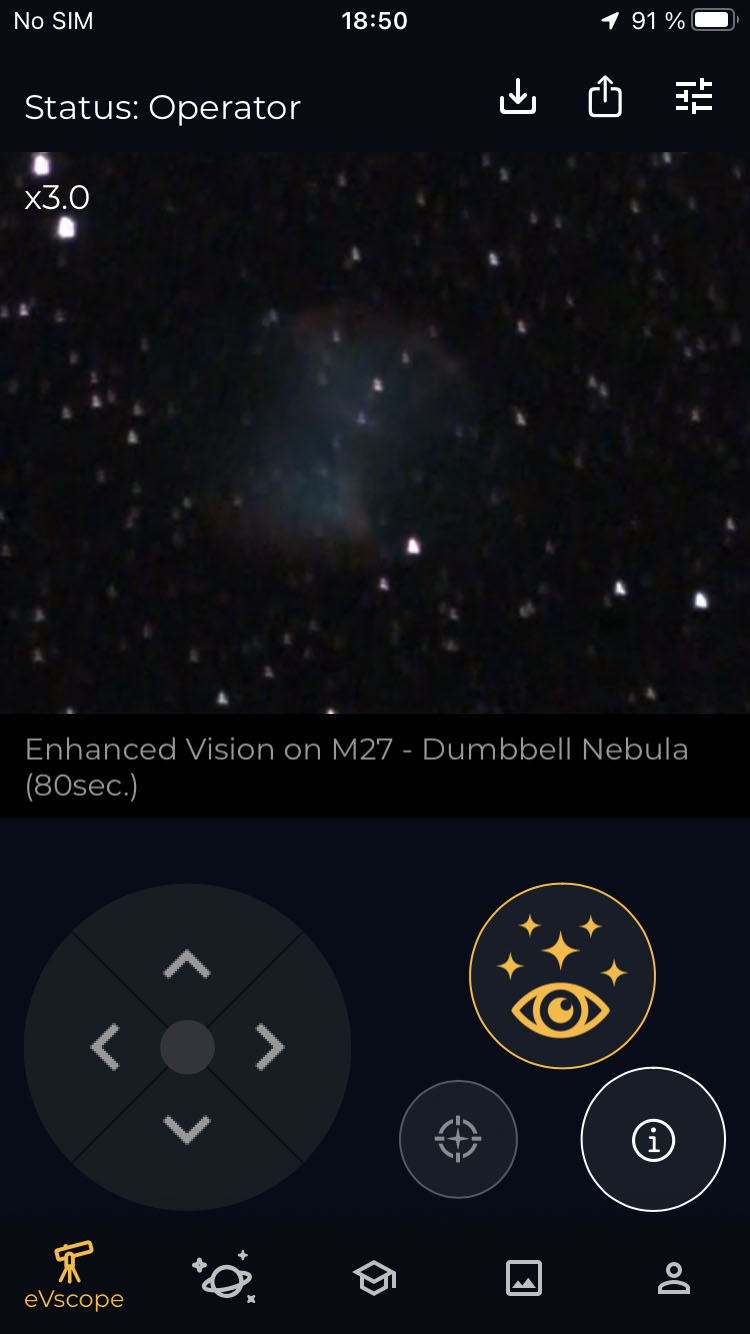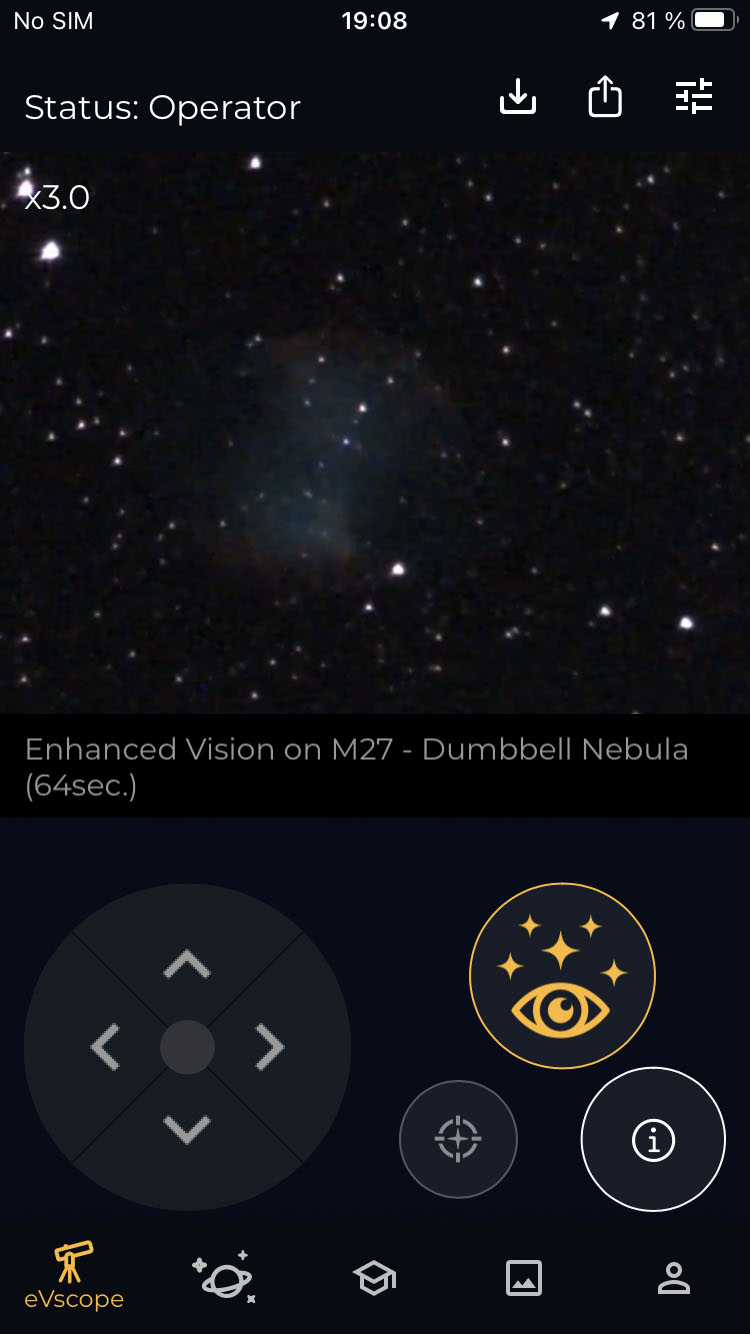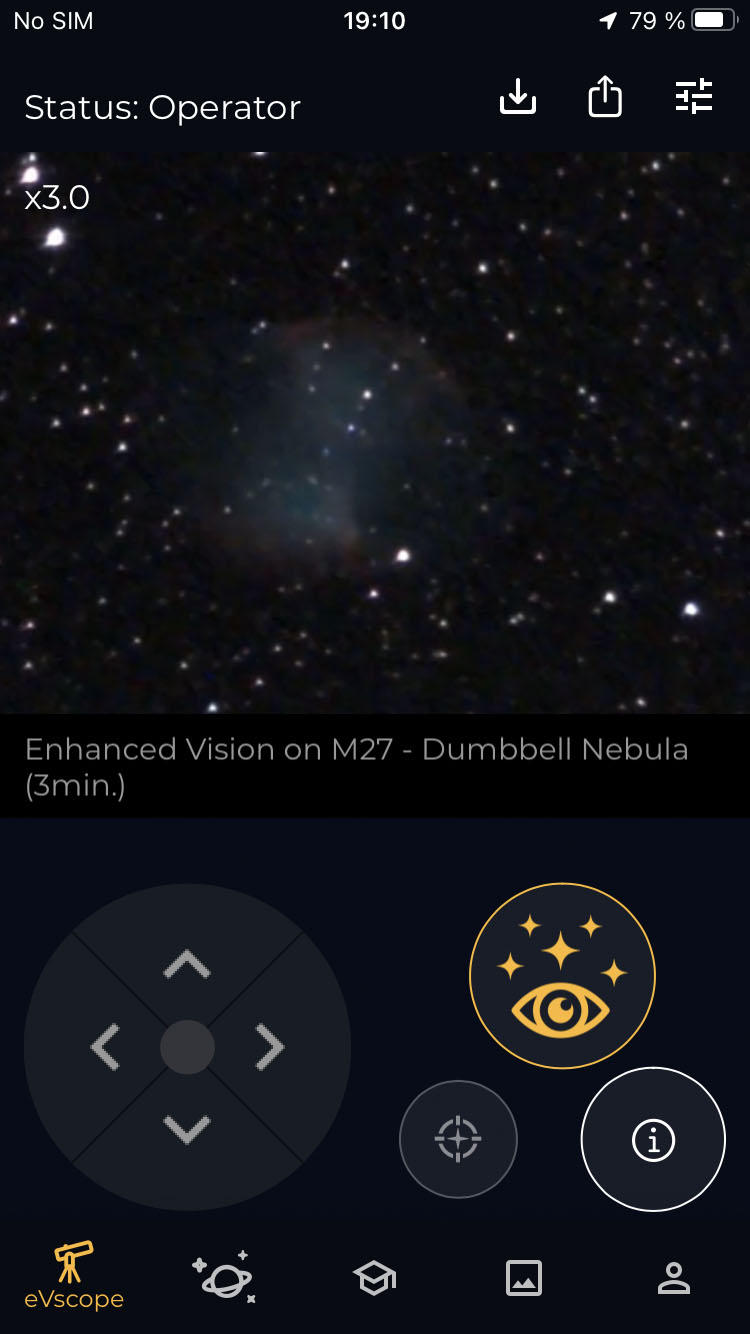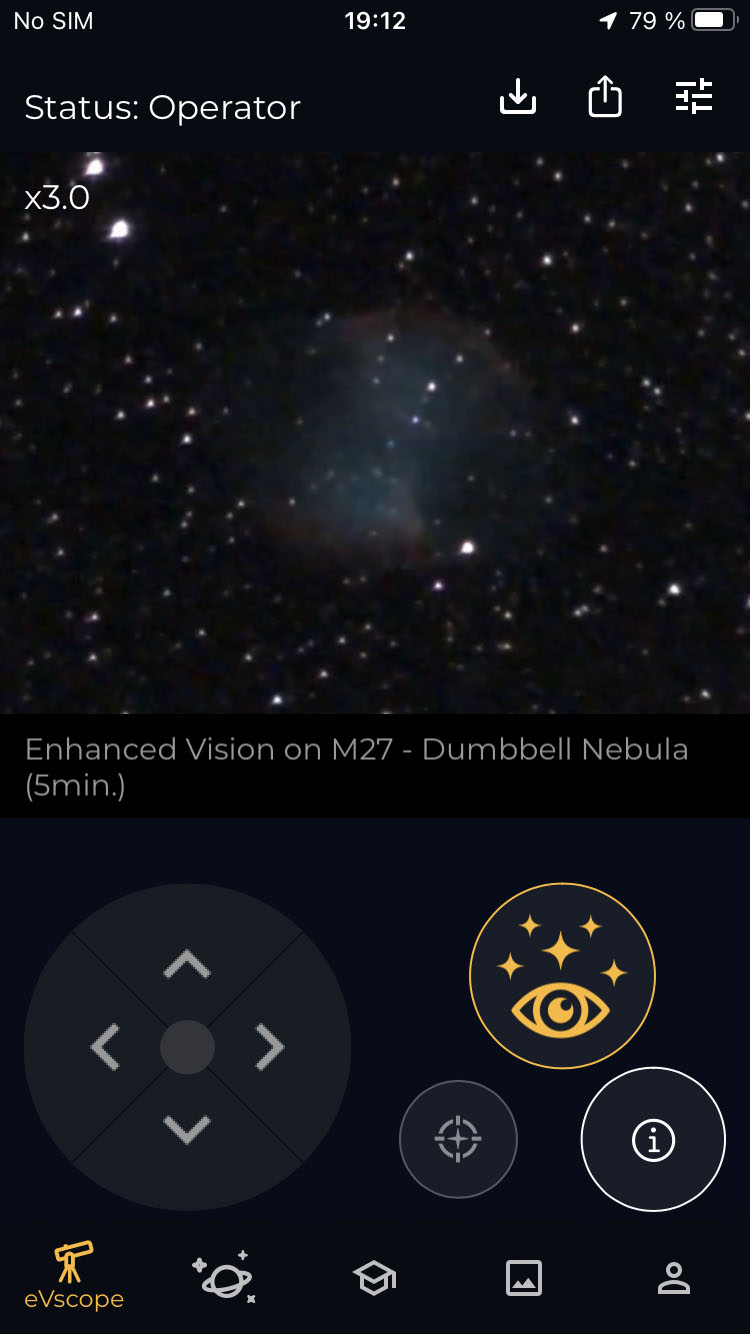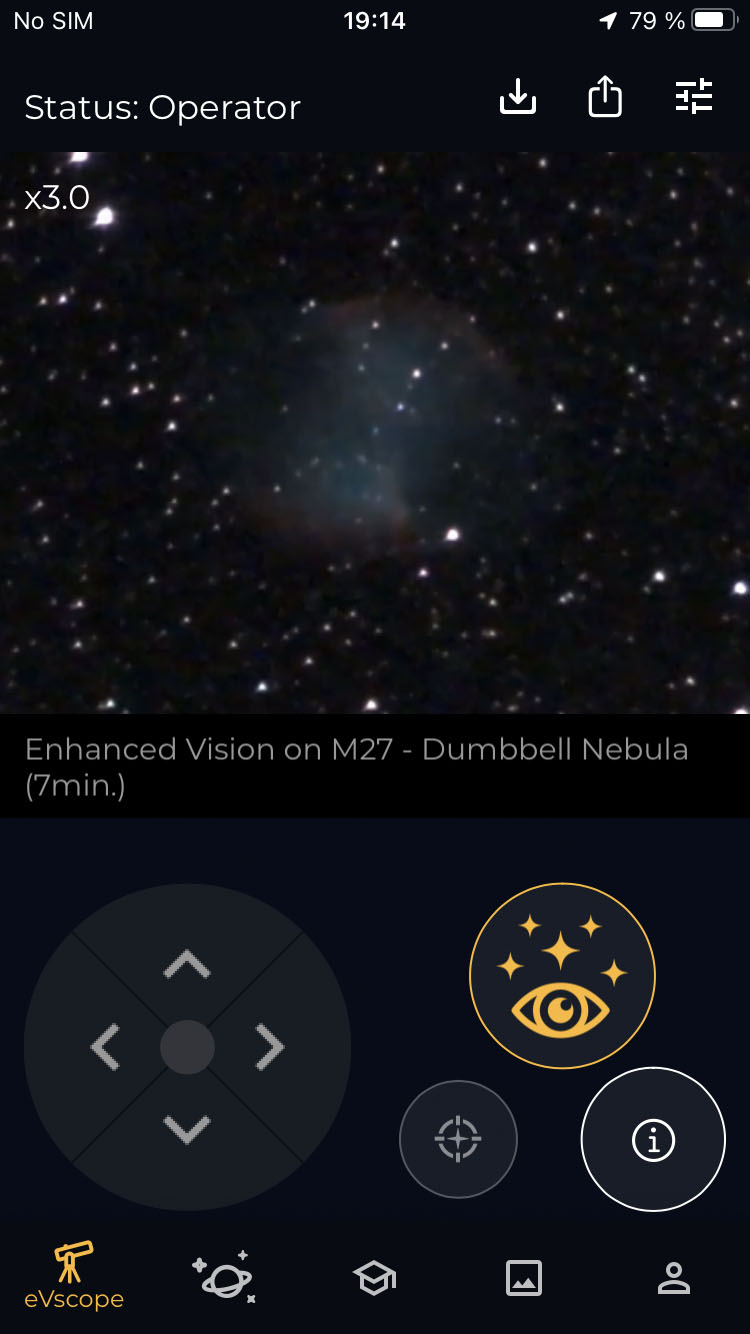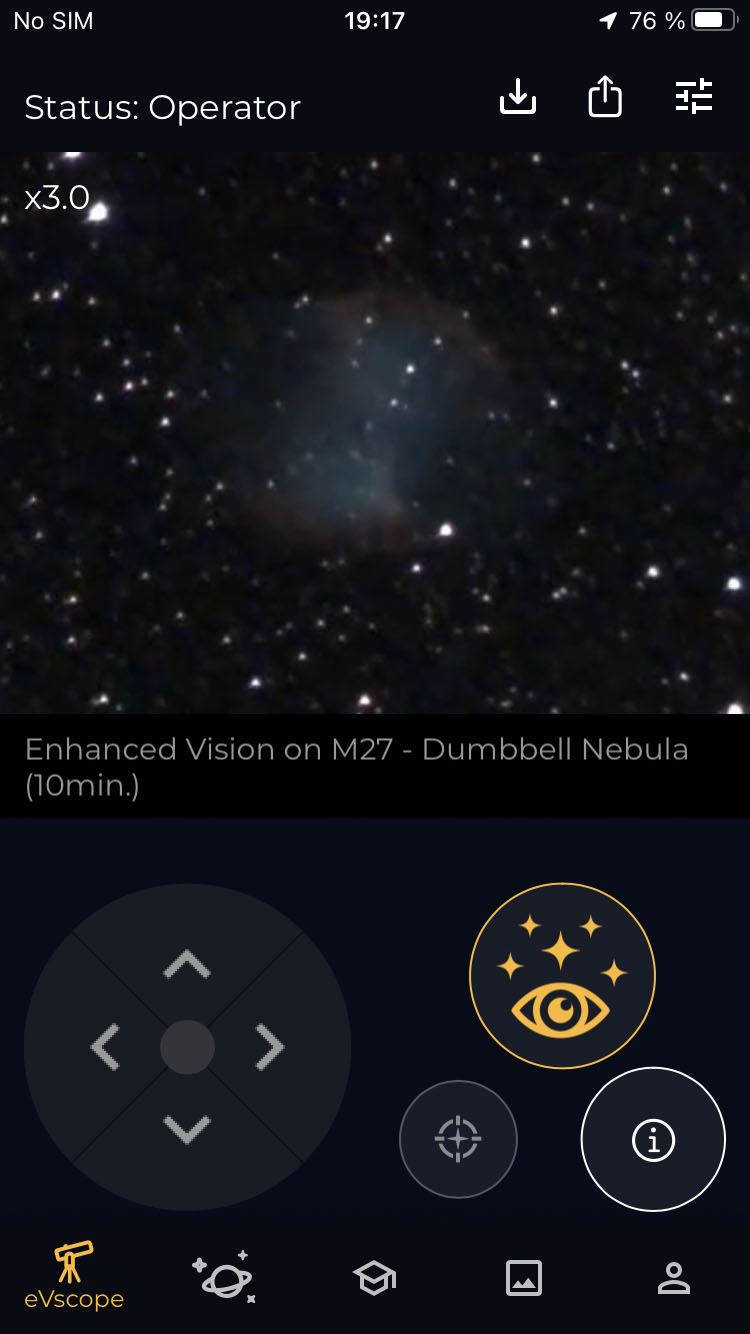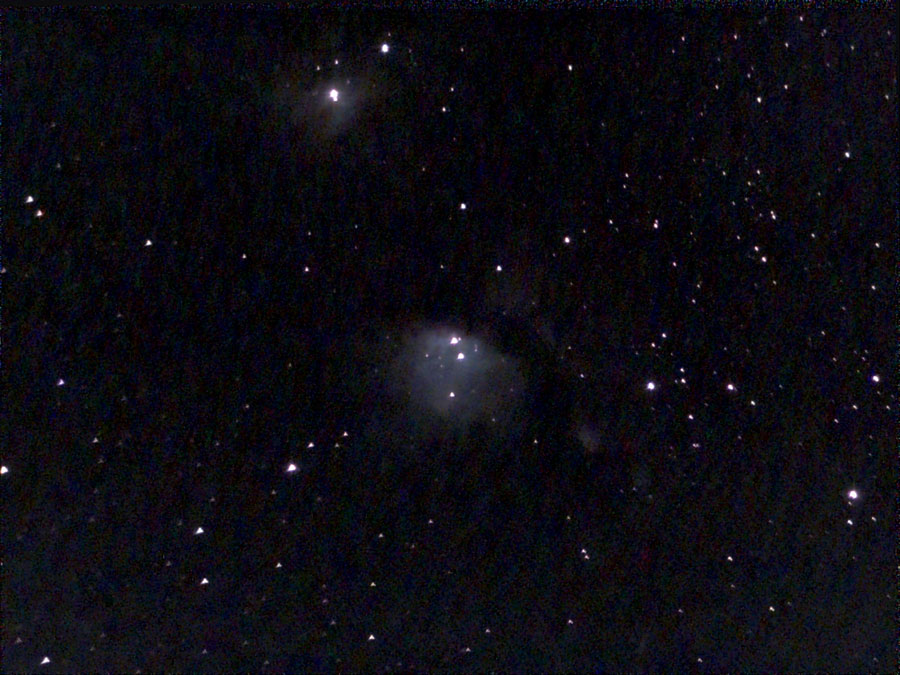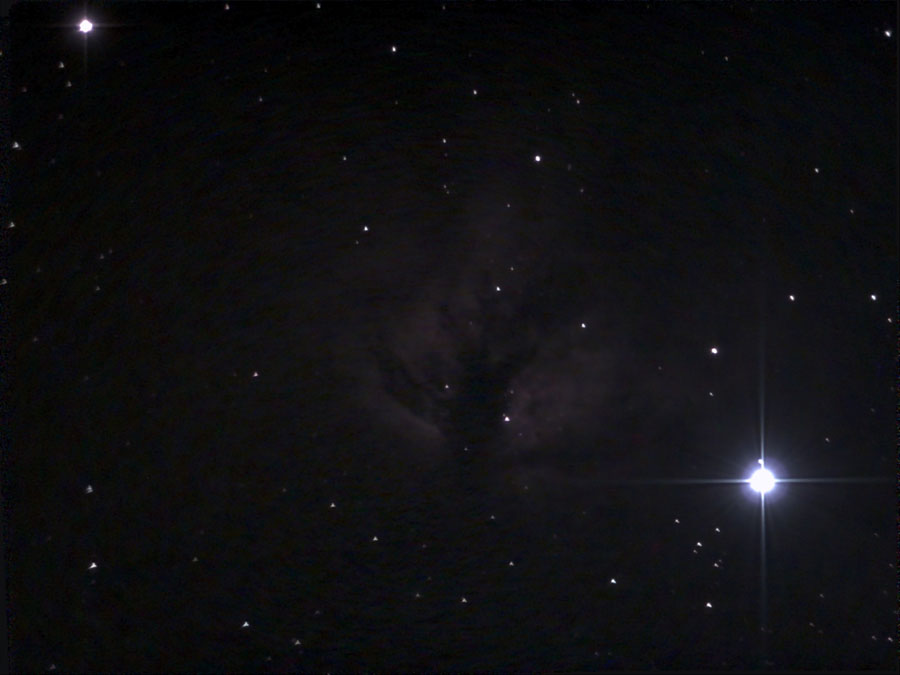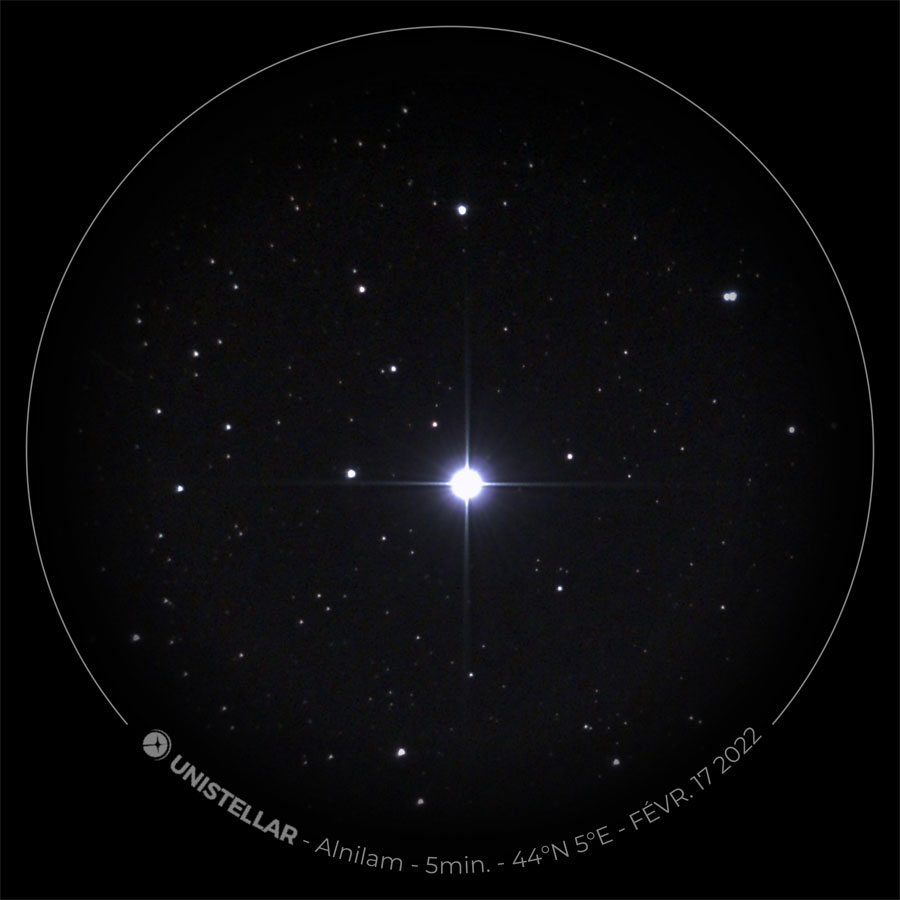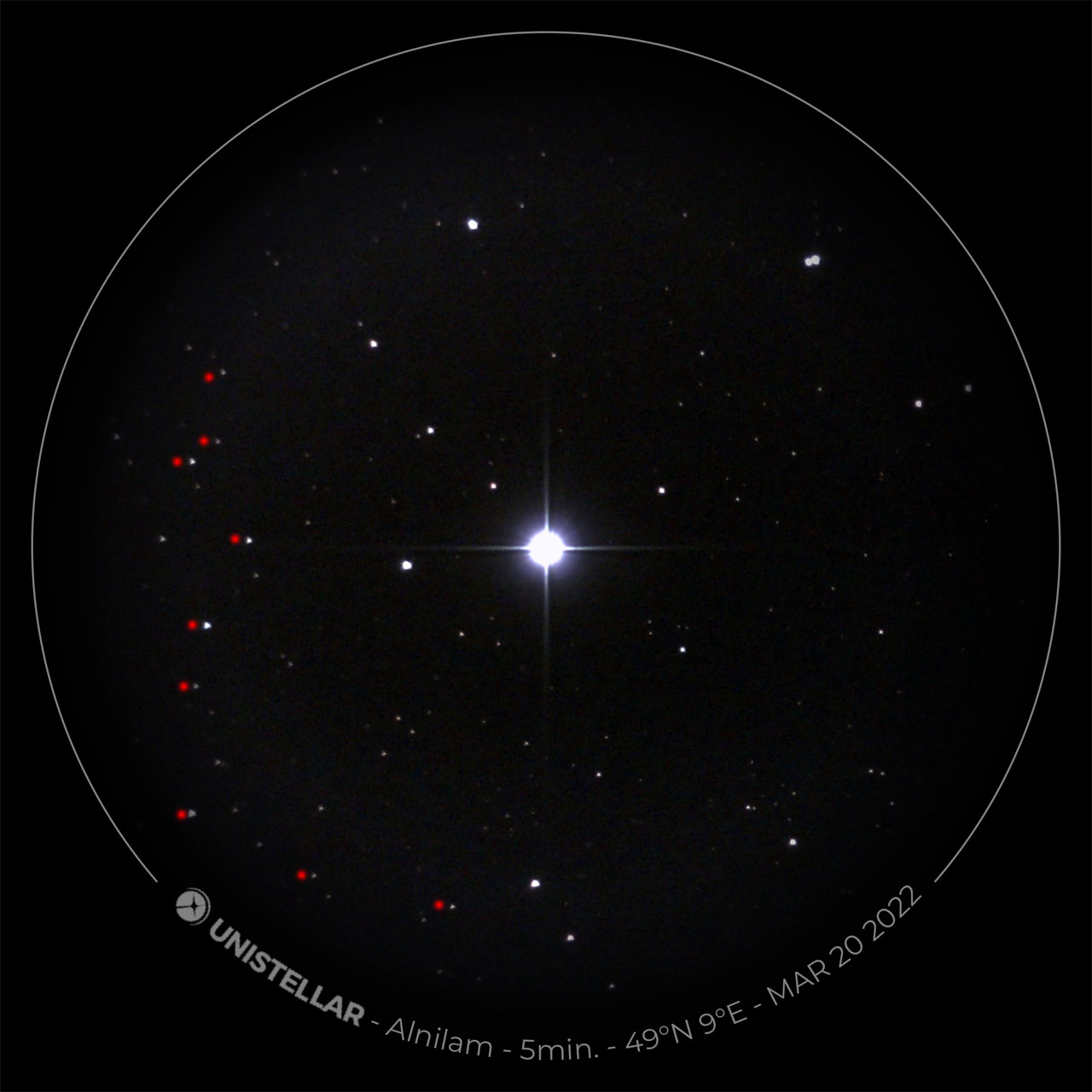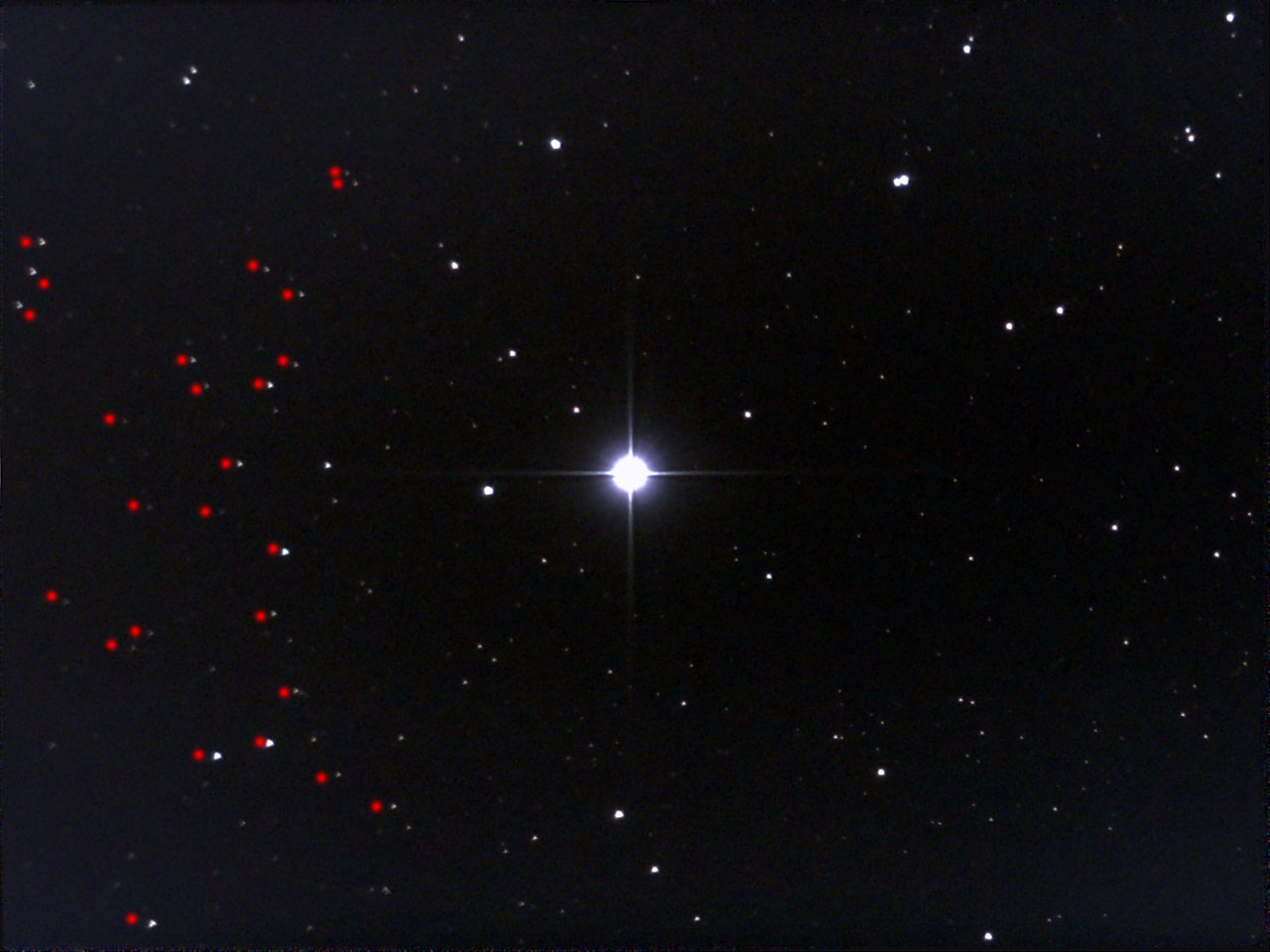Unistellar eVscope 2 - First Experiences
Introduction | Very First Experiences | Further Early Experiences and First Comparison with the eVscope | Further Experiences in 2022 | WLAN - Blues or Not? | First Conclusions | Links
Archive
On this page, I describe my first experiences (during observations) with
the first sample of my electronic 4,5" Newton
telescope Unistellar eVscope 2*. In order to save space, I also point to separate pages that describe certain things in more detail. The experiences described here range from the arrival of the eVscope in December 2021 to mid-February 2022, before I sent the eVscope 2 to Unistellar for inspection and repair (see the note below).
*) I ordered the eVscope 2 in October 2021; it arrived at the beginning of December, 2021. Since it had image problems as well, I sent it to Unistellar in early May 2022, for inspection/repair. After inspection, Unistellar offered to send me another new one, which I received on August 22, 2022 (my third new eVscope 2).
Note: Since I was not satisfied with the results of my new eVscope 2, Unistellar offered to check and possibly repair my eVscope 2. So, I sent it to Unistellar on February 14, 2022 and received information on February 18 that my eVscope 2 had been repaired and will be returned to me. When asked, I was told that there was a problem with the primary mirror, which was slightly under tension and therefore produced blurry images. As proof of the repair, I received a photo of Alnilam. It looks much better than my similar photo of Alnitak (near the Flame Nebula), but at closer look still exhibits triangular stars). Meanwhile, I was able to test my repaired eVscope 2 and report on my results on pages First Experiences (After Repair - Part 1) and First Experiences (After Repair - Part 2). According to this, the repair resulted in an improvement, but did not completely eliminate the mirror tension. Unistellar therefore offered me to return my eVscope 2 (end of March 2022) and exchange it for a new one. This arrived on April 8, 2022. So I close the pages for my first eVscope 2 sample! So please note that my eVscope 2 photos on this page do not reflect the true performance of the eVscope 2! |
Note: See page Overview of the Unistellar Pages for just that!
Introduction
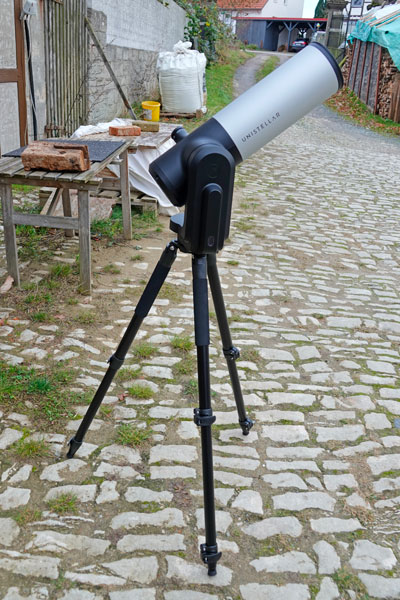 |
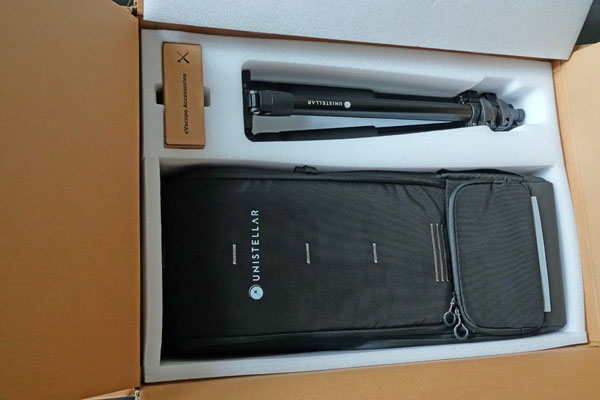 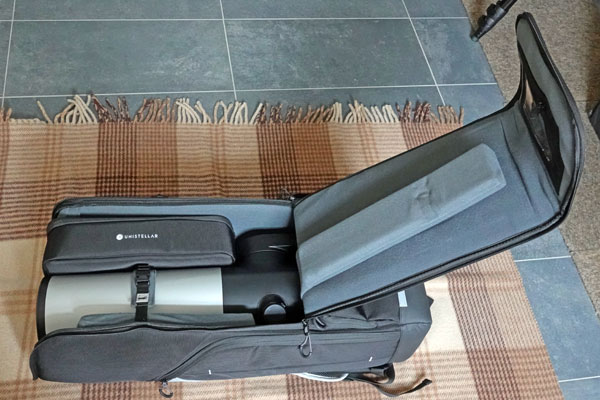 |
 |
Photos: My eVscope 2 (December 3, 2021)
In the following, I report on experiences that I made with the eVscope 2 during my first observing sessions from December 2021 to the beginning of February 2022 (before I sent it to repair). Partially, I set up my original eVscope in parallel and photographed some of the objects with it, as well, in order to compare the photos that I took with both telescopes of selected objects, mainly the Dumbbell Nebula M 27 and the Orion Nebula M 42.
Three More Observations Beforehand....
I would like to report three experiences in advance, which are difficult to accommodate elsewhere:
- The focuser has a travel of nearly 360°, with the top position roughly marking the point of focus (some manuals recommend using the center position for fast focusing; however, using the Bahtinov mask is safer). While the focuser on my original eVscope moves smoothly from left to right stop, on the eVscope 2, the focuser becomes quite hard to turn from the center to the right edge. This does not seem to be "normal" to me... I checked both focussers for this note, and overall, the eVscope focuser goes smoother than the one from the eVscope 2.
- When I had the two eVscopes side by side in Mühlhausen and had them tracking, the eVscope 2 made faint ticking noises (hard to describe...), whereas the old eVscope made no noise. I would have thought that nothing has changed in the mechanics and that both eVscopes should behave the same...
- Later, I also discovered that, when accessing a target, the evscope 2 makes much less noise than the original eVscope.
Very First Experiences (December 5 and 10, 2021)
On the first day (December 3, 2021), I unpacked the eVscope (and took pictures) and charged the battery. This time, everything went much smoother than with the predecessor (although I was not quite sure, whether the eVscope 2 would charge correctly...). And despite the alleged 2-3 weeks of bad weather, which you get for free with every new telescope, I was able to make first observations in Erkerode already on December 5 and 10, 2021.
December 5, 2021, Erkerode
Focusing was done with the Bahtinov mask. At the end of the session, I made some collimation attempts; in the process, the Unistellar app constantly switched me from an "operator" to an "observer", even though I was standing next to the telescope with my iPad; this did cost a lot of time. On top of that, I had forgotten the details of how to collimate the eVscope (2), because I had not informed myself beforehand. And very soon, upcoming clouds prevented further collimation attempts...
iPad (5:20-6:20 p.m.): M 2, M 15, M 27; M 57 did no longer work...
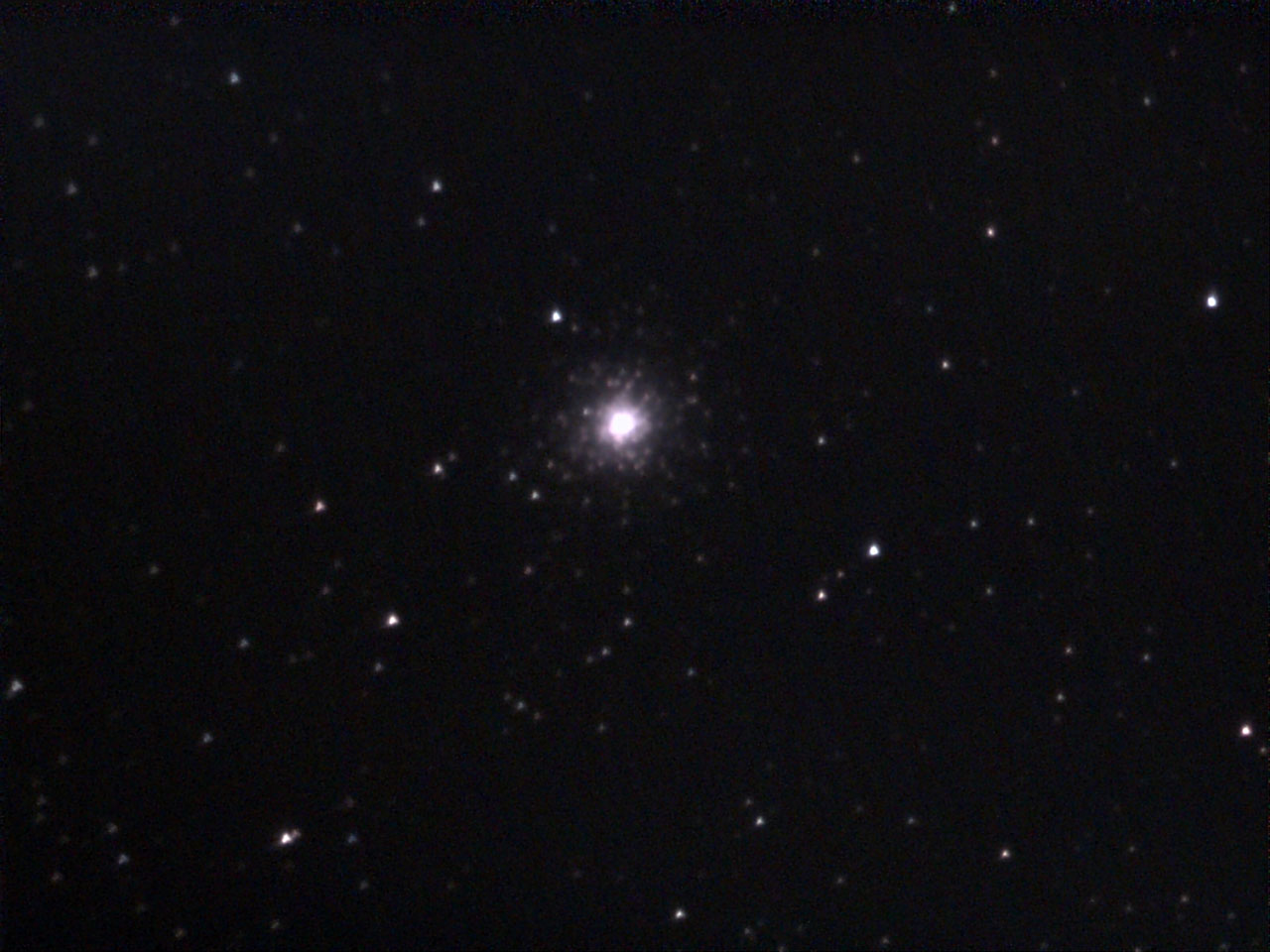 |
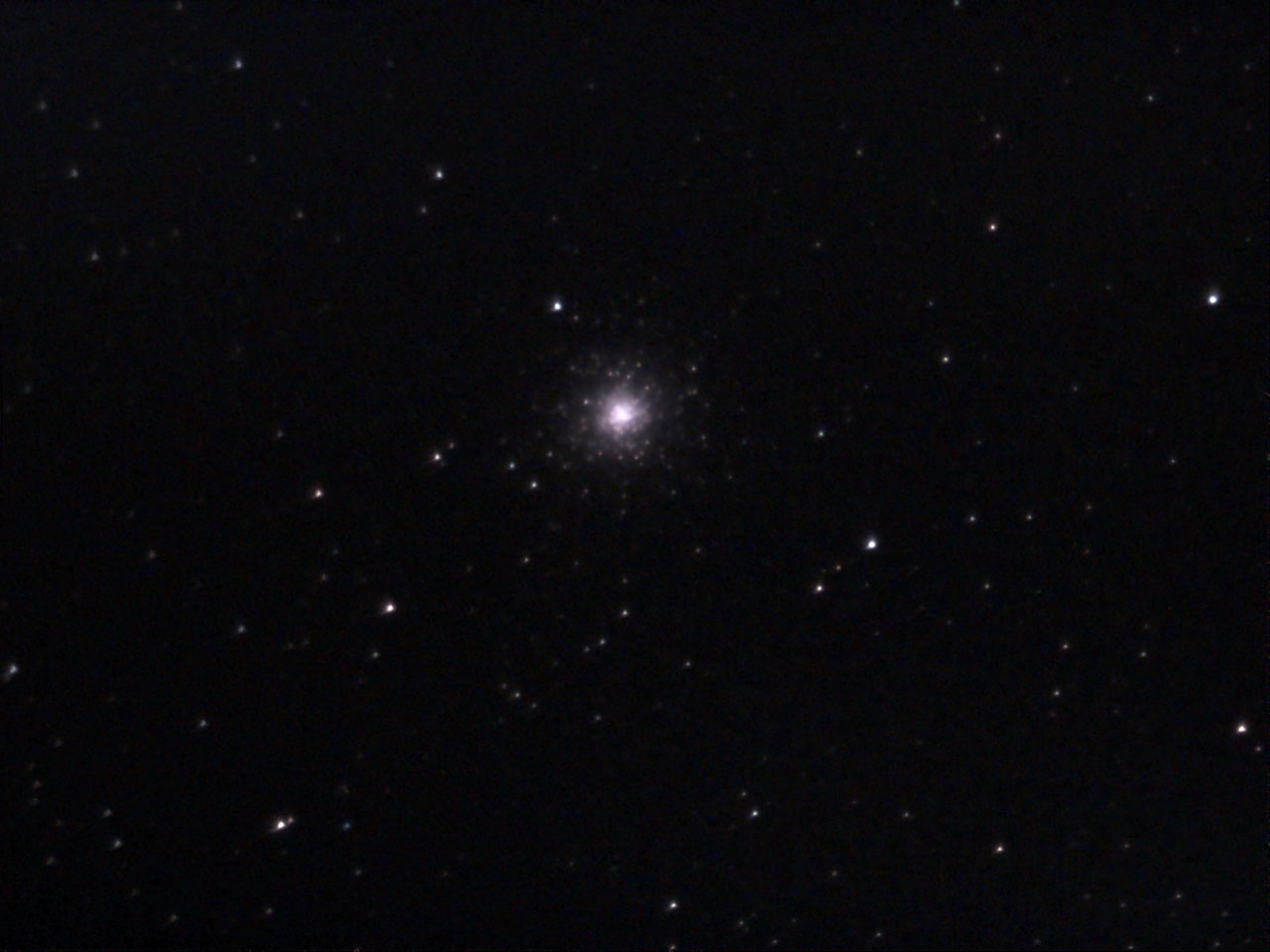 |
|
M 2 - eVscope 2, Dec 5, 2021, unprocessed (original size) |
M 2 - eVscope 2, Dec 5, 2021, unprocessed (original size) |
|
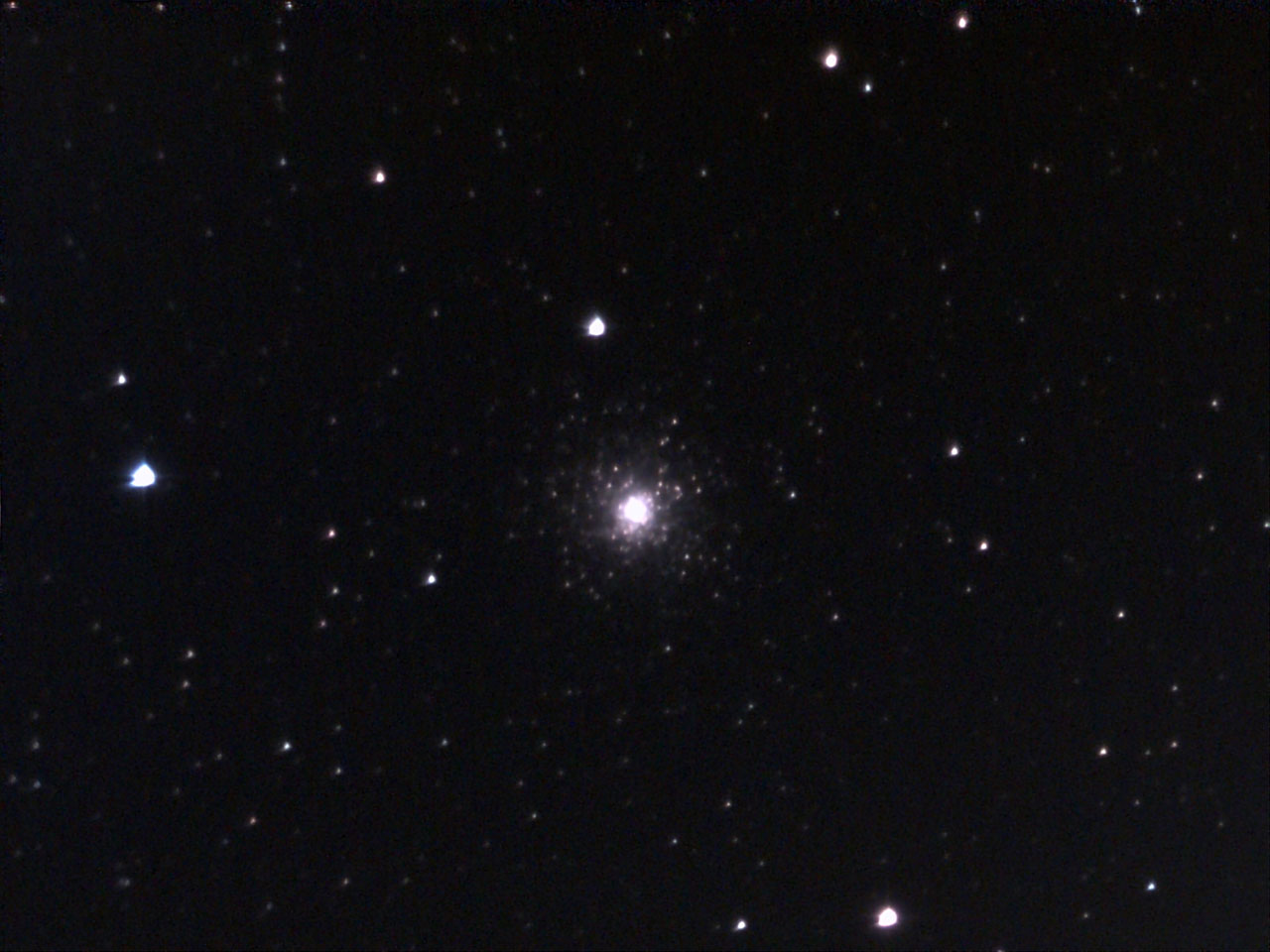 |
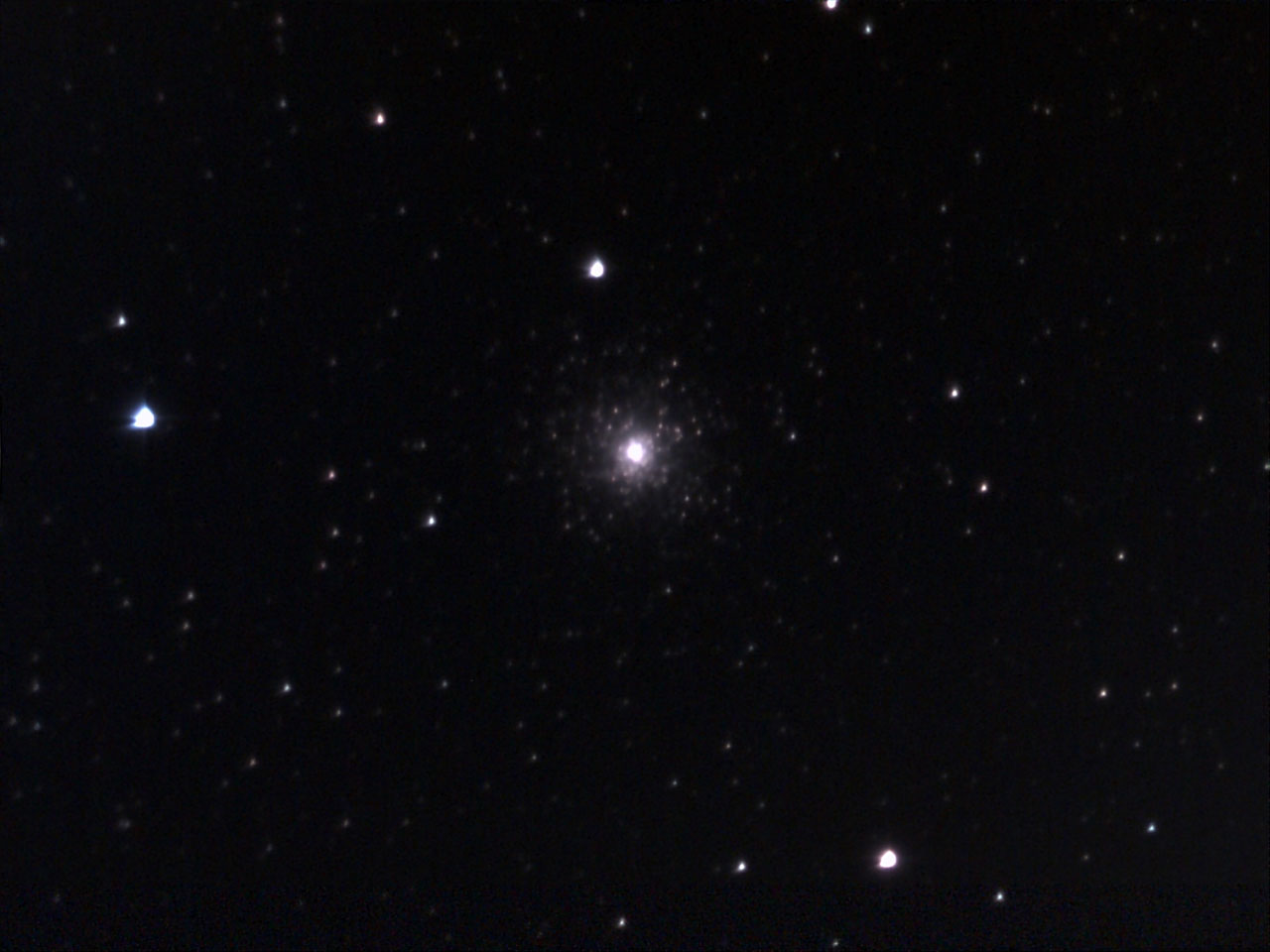 |
|
M 15 - eVscope 2, Dec 5, 2021, unprocessed (original size) |
M 15 - eVscope 2, Dec 5, 2021, unprocessed (original size) |
|
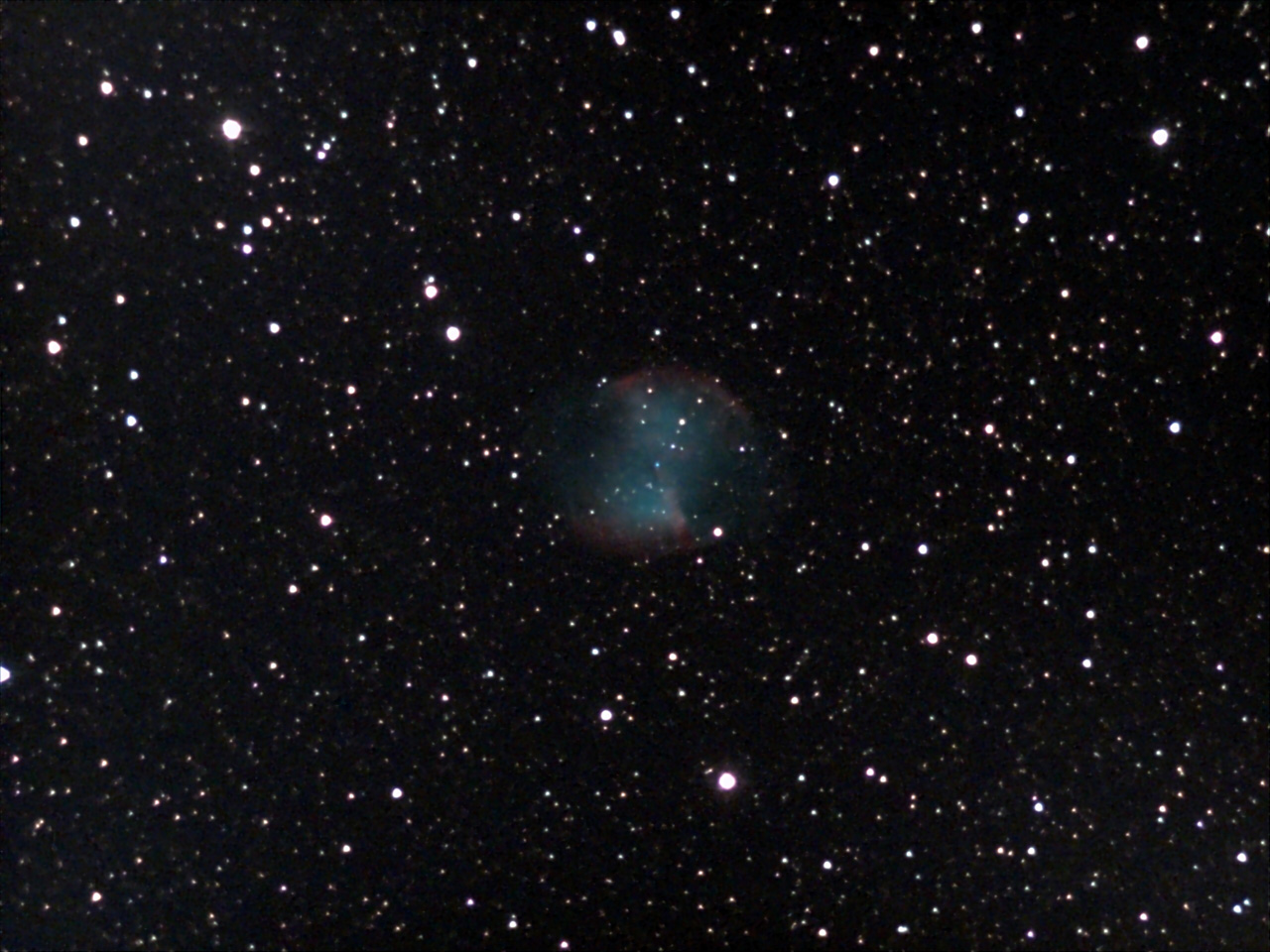 |
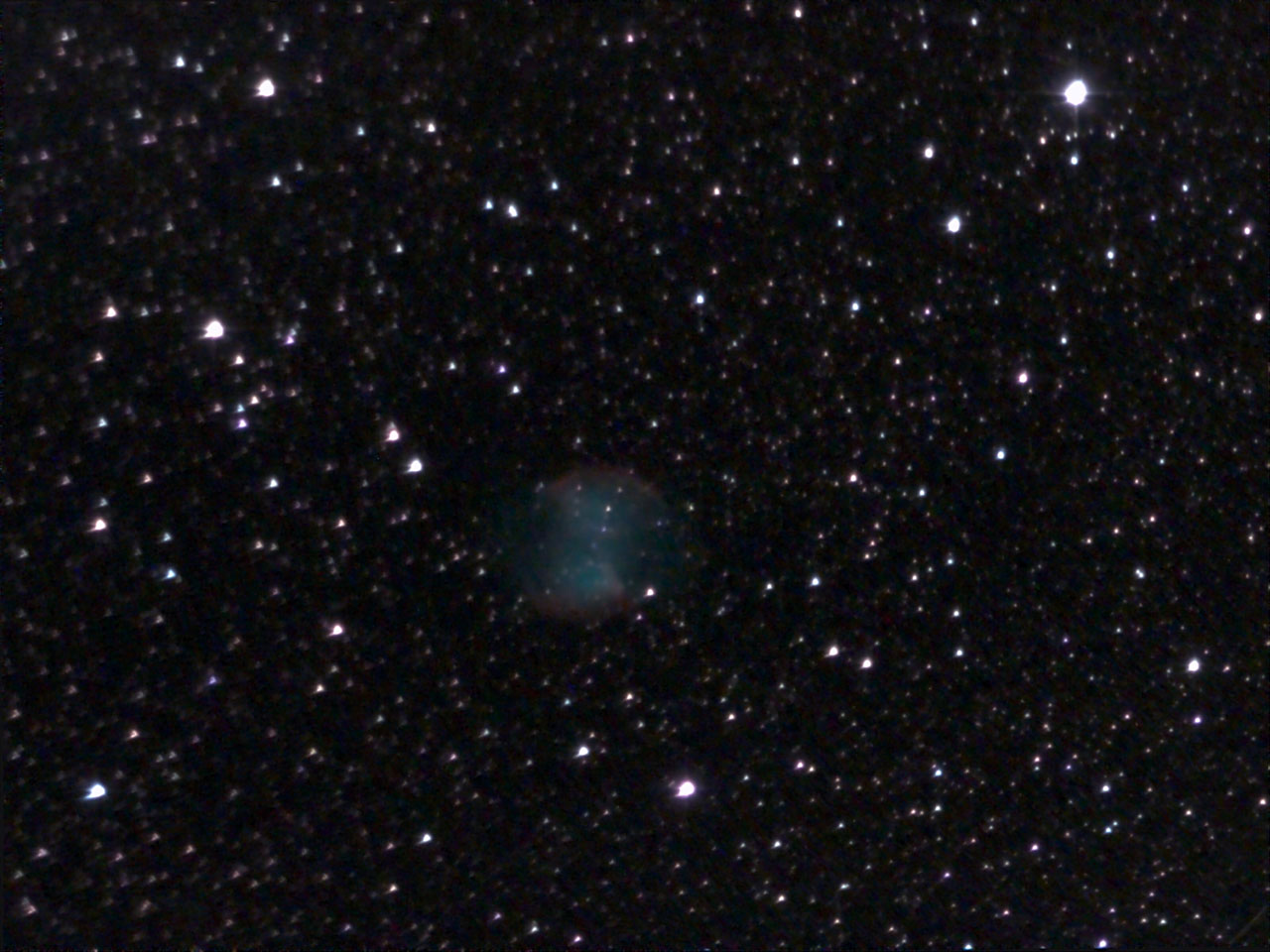 |
|
M 27 - eVscope, 19.10.2021, unprocessed (original size), for comparison |
M 27 - eVscope 2, Dec 5, 2021, unprocessed (original size) |
Because many globular clusters are washed out at their bright cores since the introduction of the new image processing, they are not suited to comparisons. I therefore used M 27 (Dumbbell Nebula) for my comparisons (bottom row) and judgements. Compared with the original eVscope (bottom left), the eVscope 2 image (bottom right) exhibits poorer star shapes and misses small stars in the nebula. The stars that are visible in the nebula are also out of focus (blurry); overall the eVscope 2 photo looks blurry, despite the fact that I used a Bahtinov mask for focusing. I therefore assumed that the telescope was poorly collimated after its "long trip" to me. I was not at all satisfied with this state of affairs. In fact, I was disappointed. However, I had to abort my collimation attempts (see above). As I found out only later, I had better tried to improve the focus instead...
Update: After looking at my photos and those posted by Alexander Kerste on his blog, I conclude that my eVscope 2 was not properly focused despite of the use of the Bahtinov mask.
Further update: See conclusions!
Dec 10, 2021, Erkerode
Focusing was once again done with the Bahtinov mask; I made three collimation attempts, the first two without noticeable effect (initially, the collimation image was still very "wobbly" (tube seeing)). Later, at my third attempt, the collimation went much better, however, without producing really good results. But using M 27 for comparison, I was able to clearly see the improvement that my third collimation attempt had brought.
iPad (6:00-8:00 p.m.) : M 57, M 27, collimation, M 27, moon (nearly half), NGC 6992 (Eastern/Western Veil Nebula the same! -> error in eVscope data base), M 2, M 15, NGC 7313 (Stephan's Quintet), M 31, M 33, Perseus Double Cluster (first H = NGC 869, then Chi = NGC 884), M 76
Twice the eVscope2 accessed the previous target instead of the selected one;
only with some trickery, the new target could be accessed again. chi Persei
was not hit properly either....
This time, I had no "control losses", but a few minor quirks.
Sometimes, saving the images took forever, the processor seemed to be overwhelmed.
The WLAN range seemed to be a bit better with the eVscope 2 than with the eVscope,
but I had no direct comparison...
In the following, I present only photos of M 27, which I took on Dec 10, 2021 with the eVscope 2 and palce, for comparison purposes, the photo from Dec 5 and one taken with the original eVscope next to them:
 |
 |
|
M 27 - eVscope, Oct 19, 2021, unprocessed (original size), for comparison |
M 27 - eVscope 2, Dec 5, 2021, unprocessed (original size), for comparison |
|
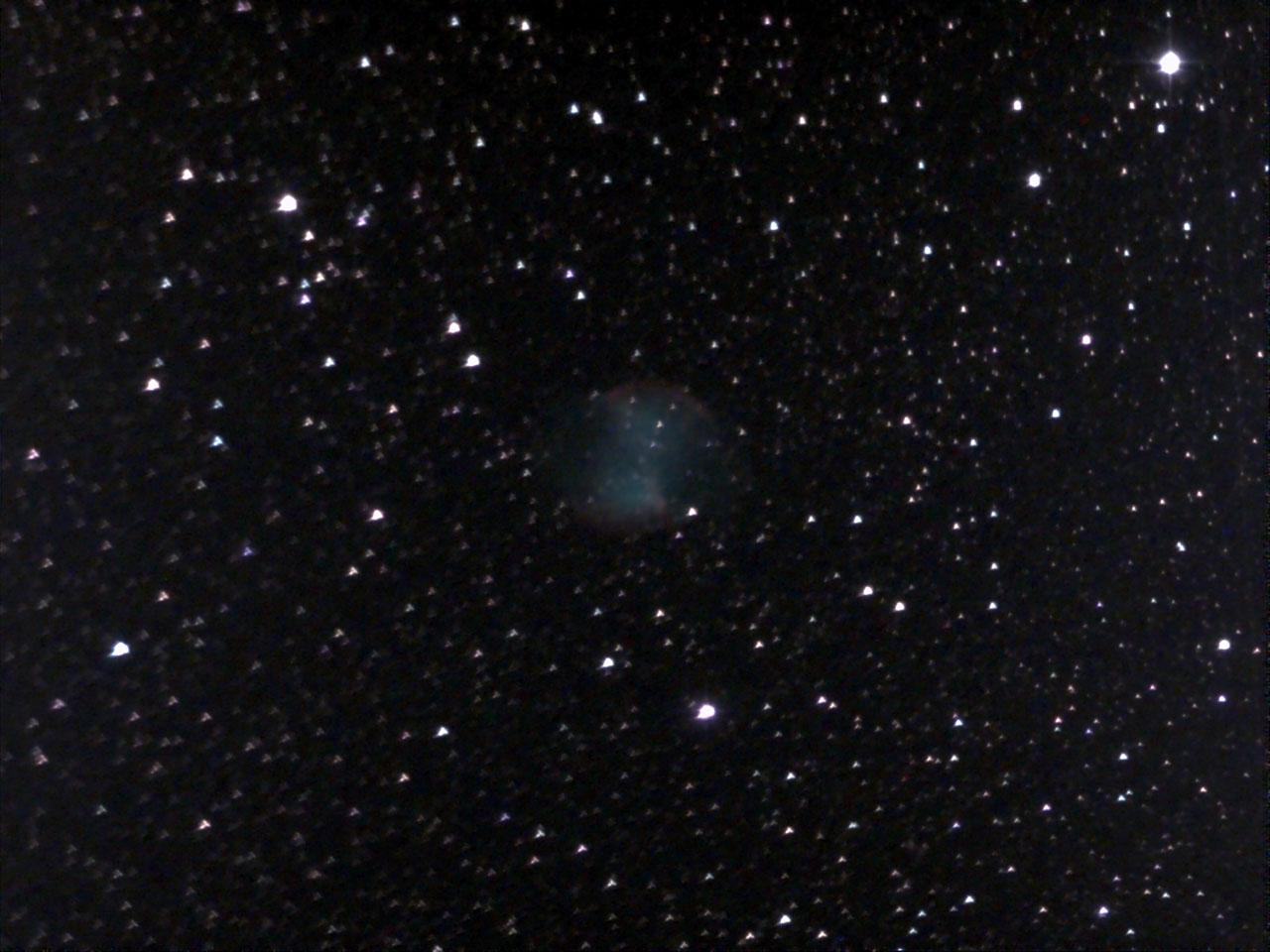 |
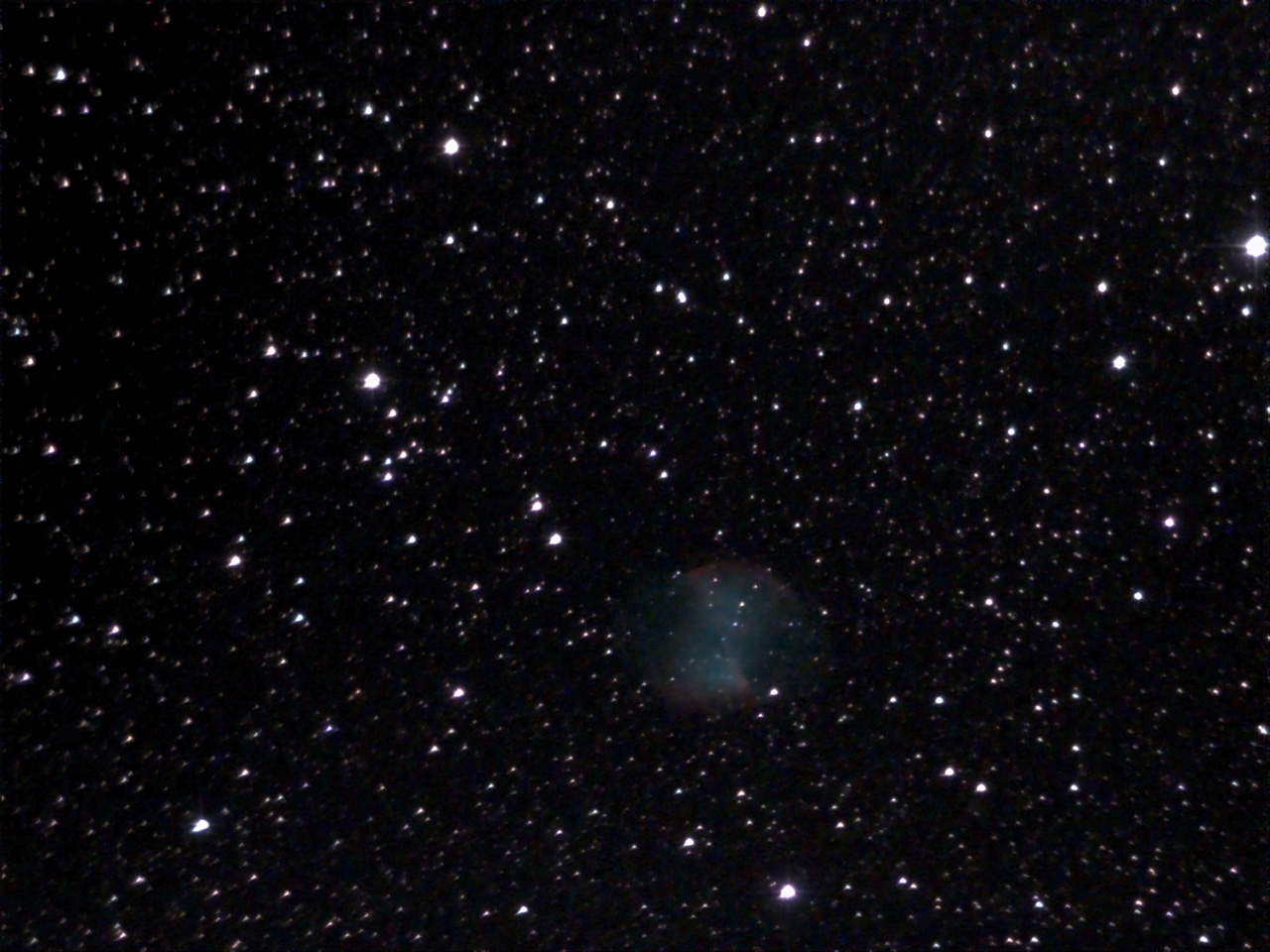 |
|
M 27 - eVscope 2, Dec 10, 2021, unprocessed (original size) |
M 27 - eVscope 2, Dec 10, 2021, unprocessed (original size), after collimation |
The photo taken after collimation showed a significant improvement in the sharpness and definition of the stars in the nebula, while the star shapes had improved little or not at all. In any case, the photo after collimation (bottom right) made a much better impression than any previously taken with the eVscope 2! So there was now reason for hope! Despite all this, it still did not come close to the eVscope photo...
I present photos of other DSO that I took with the eVscope 2 on that day on a separate page!
Update: See conclusions!
Conclusions
These first results were disappointing for me. So I assumed that my eVscope 2 was, probably due to the long transport, decollimated. My collimation attempts were hampered by technical problems and lack of knowledge on Dec 5, 2021, and quickly stopped by oncoming clouds.... On Dec 10, 2021, I was able to get the eVscope 2 out again, collimate it, and get a slight improvement on my third collimation attempt (see photo at the bottom right). So I observed with the eVscope 2 for a while, accesssing and photographing a number of DSO (with the eVscope 2 making a couple of errors...).
Only later did I realize that it was not easy to tell whether the improvements were a result of collimation or of refocusing after collimation, because after each collimation it was necessary to refocus. More on this on page Finding and Judging Problems in eVscope (2) Photos.
Update: Since I was not satisfied with the results of my new eVscope 2, Unistellar offered to check and possibly repair my eVscope 2. So, I sent it to Unistellar on February 14, 2022 and received information on February 18 that my eVscope 2 had been repaired and will be returned to me. When asked, I was told that there was a a problem with the primary mirror, which was slightly under tension and therefore produced blurry images. So probably misfocus and mirror tension were the main reasons for my poor image result.
That means that my "main problem" was a mirror that was under tension! In the end, all other measures, like collimating and focusing, can only bring substantial improvements after the "basic problem" (the tense mirror) has been eliminated...
Further Early Experiences and First Comparison with the eVscope (December 20 and 21, 2021)
Ten days later, back in Mühlhausen, there were two clear nights in a row where I was able to further test the eVscope 2 and compare it directly with the original eVscope. However, these observations and evaluations also were hampered by the fact that I had not recognized that the eVscope 2's main mirror was under tension...
December 20, 2021, Mühlhausen
At my first eVscope/eVscope 2 session in Mühlhausen, I tested both telescopes on M 27 only. My collimation efforts did not show any improvements, with the original eVscope having even a deterioration thereafter.
SQM almost 19; 6:10-7:10 p.m.
| eVscope | eVscope 2 | |
iPhone (6:10-7:10 p.m.): Collimation checked, M 27, Collimation, M 27 (up to 15 min, elongated stars |
iPad (6:20-7:00 p.m.): Collimation, M 27, collimation, M 27 iPhone (7:00-7:10 p.m.): M 27 |
After I had replaced the iPad with an iPhone due to power shortages, the screen images of both telescopes looked more similar. The iPad's large screen made the eVscope 2's images look fuzzier than they might have been. The next day, I also realized that I had set the brightness of the screen of the second iPhone too low, so the eVscope 2 images looked darker. I even had suspected that the new sensor was less sensitive than the old eVscope's. However, that does not seem to be the case...
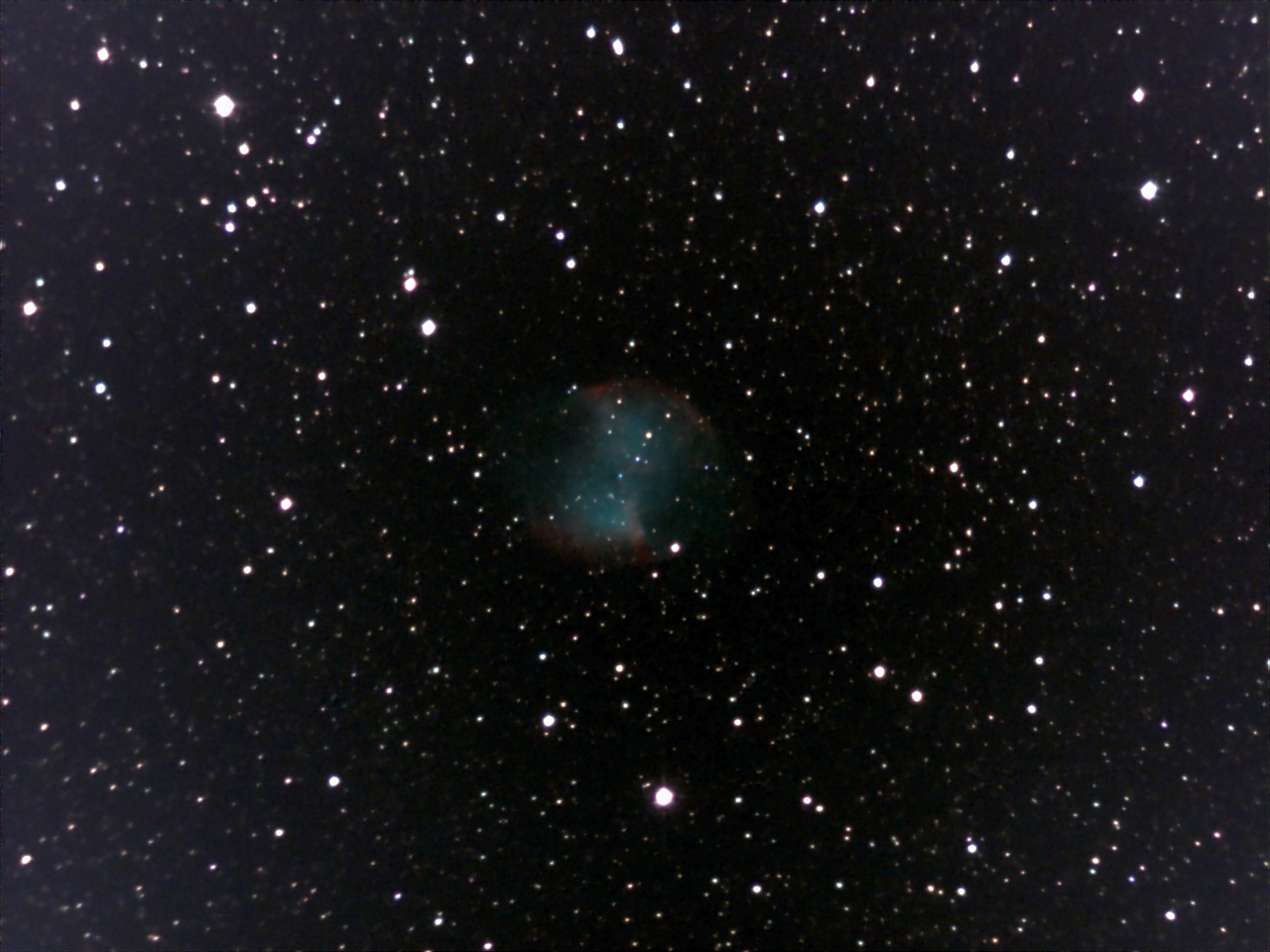 |
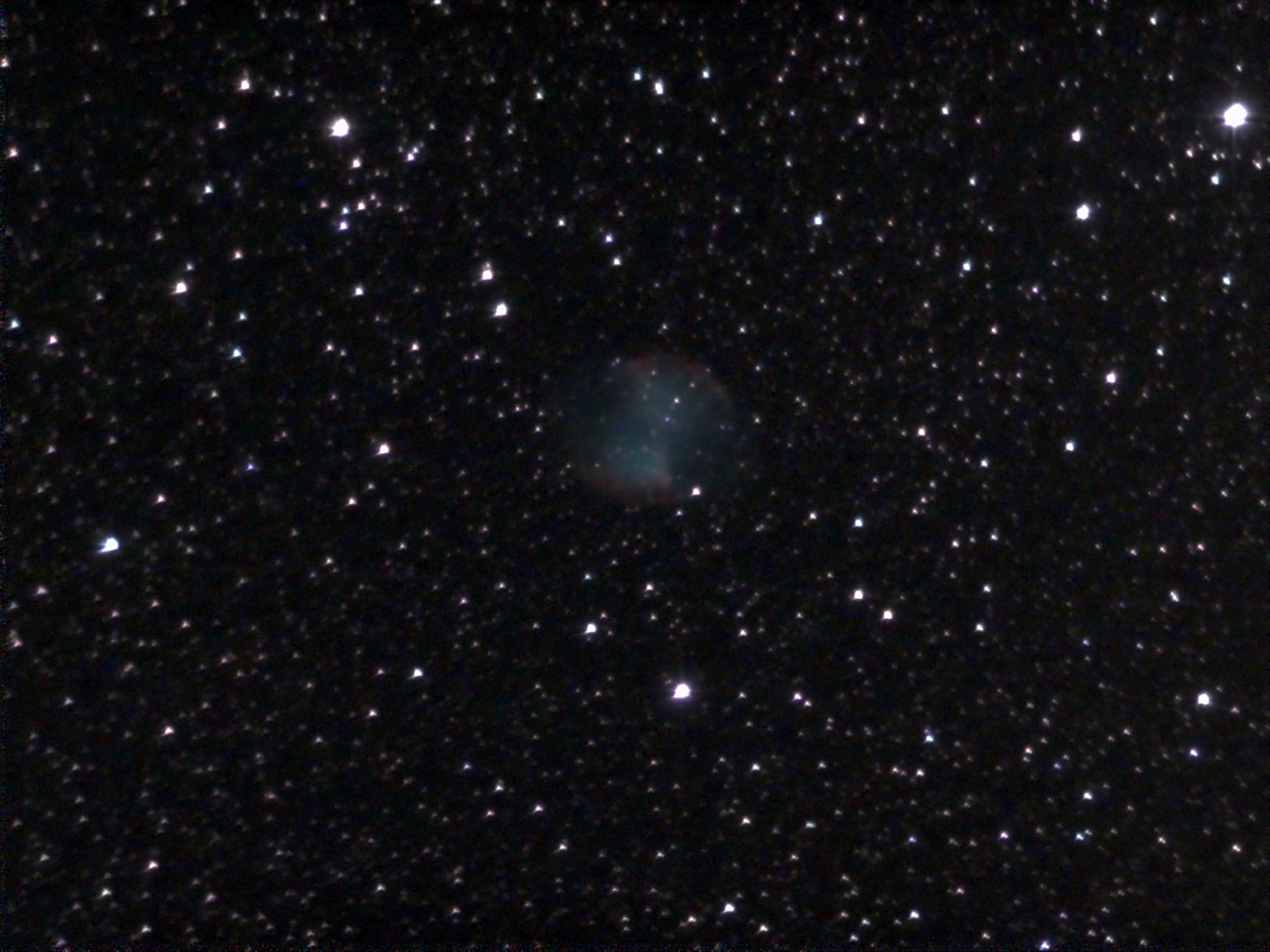 |
|
M 27 - eVscope, Dec 20, 2021, unprocessed (original size), before collimation (only checked) |
M 27 - eVscope 2, Dec 20, 2021, unprocessed (original size), after first collimation (made worse) |
|
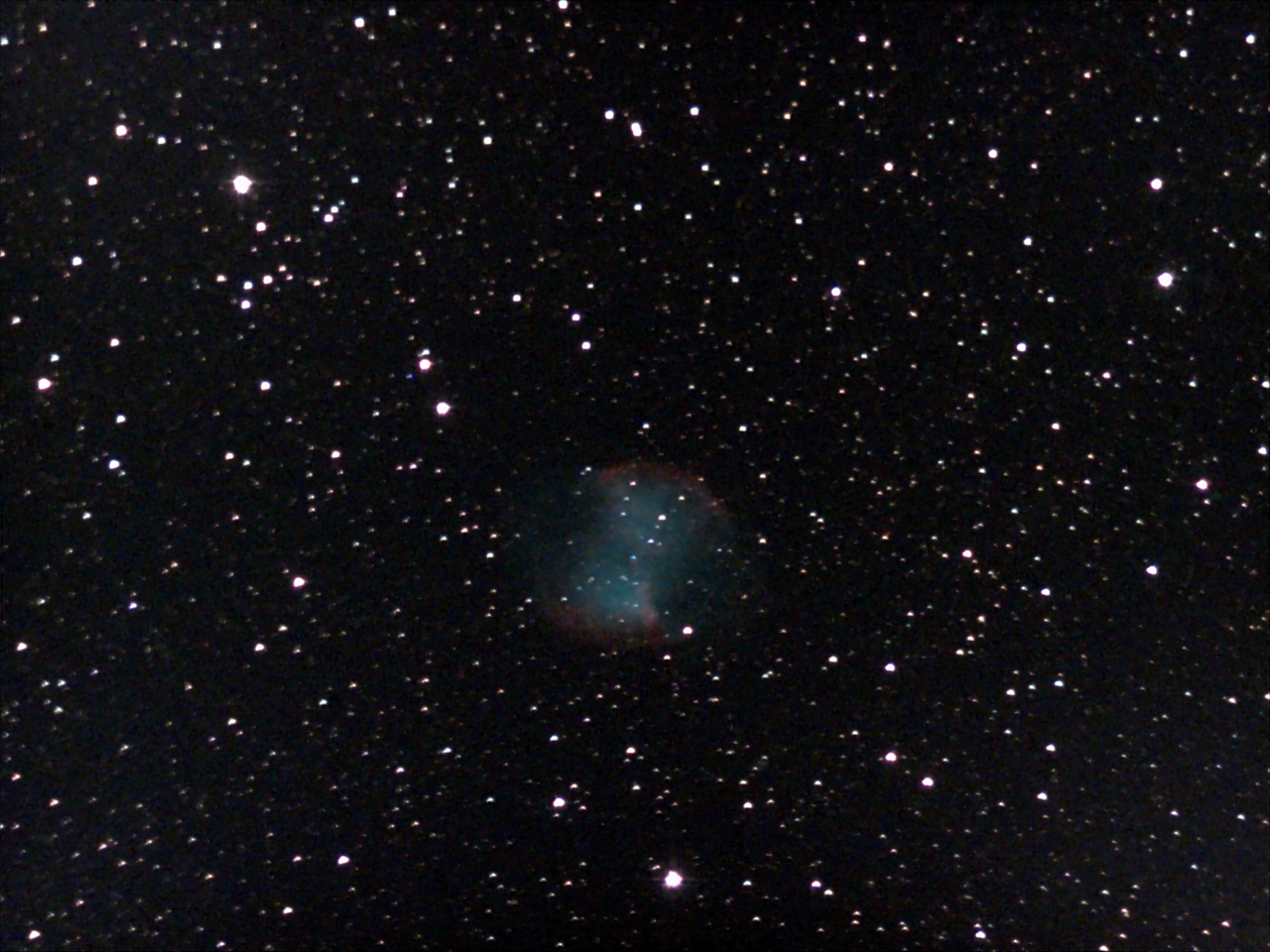 |
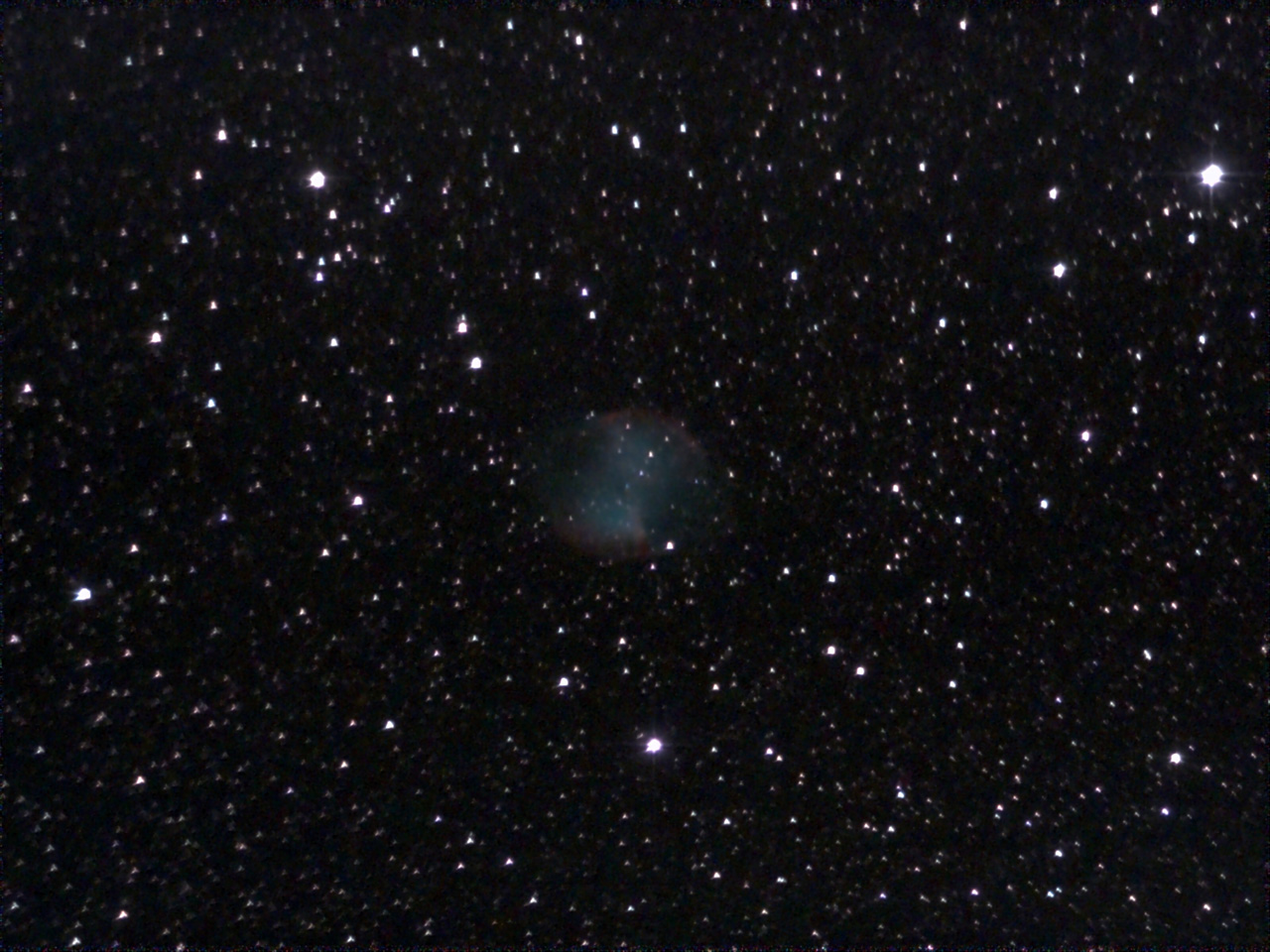 |
|
M 27 - eVscope, Dec 20, 2021, unprocessed (original size), after collimation (made worse) |
M 27 - eVscope 2, Dec 20, 2021, unprocessed (original size), after second collimation |
|
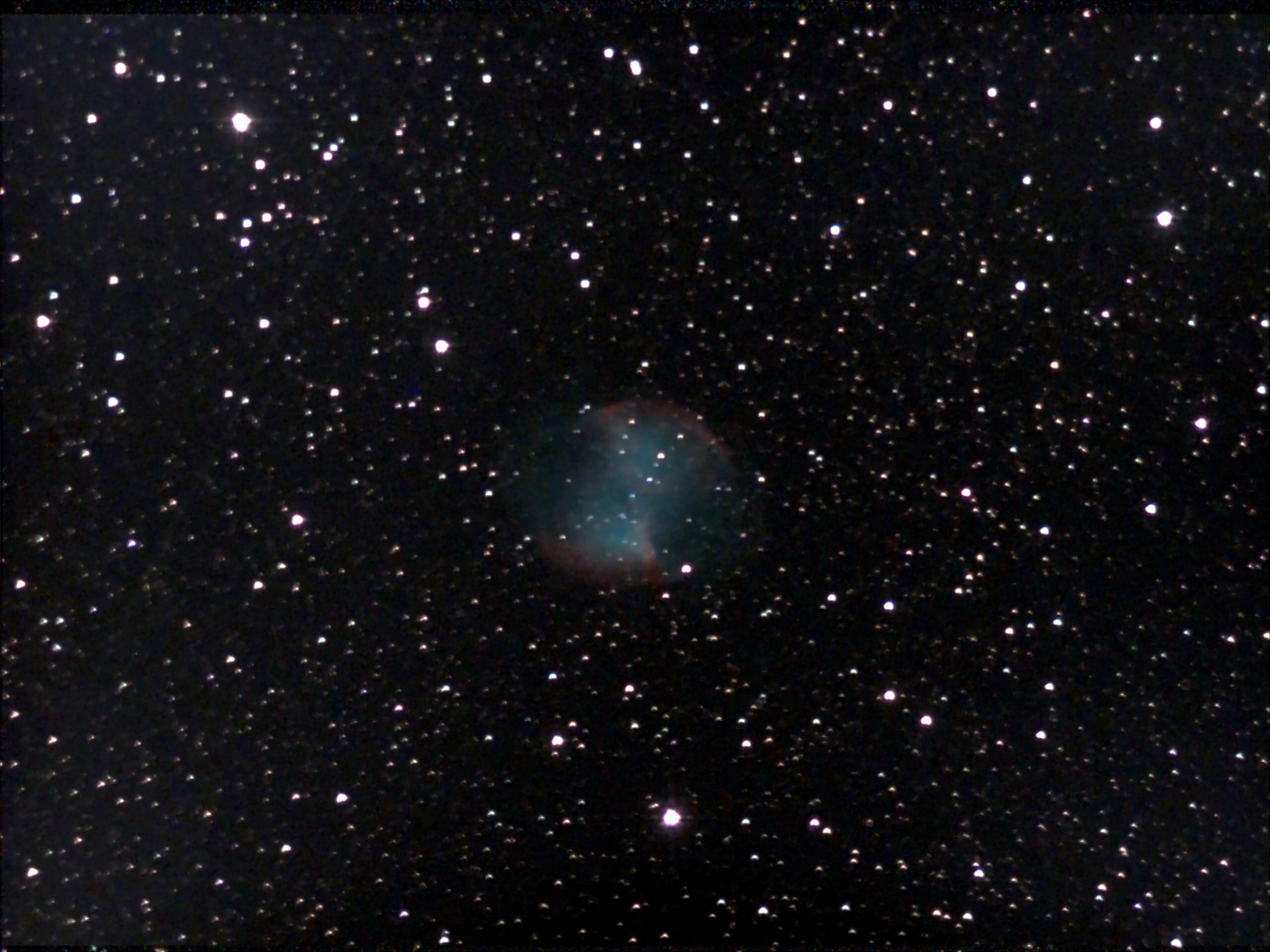 |
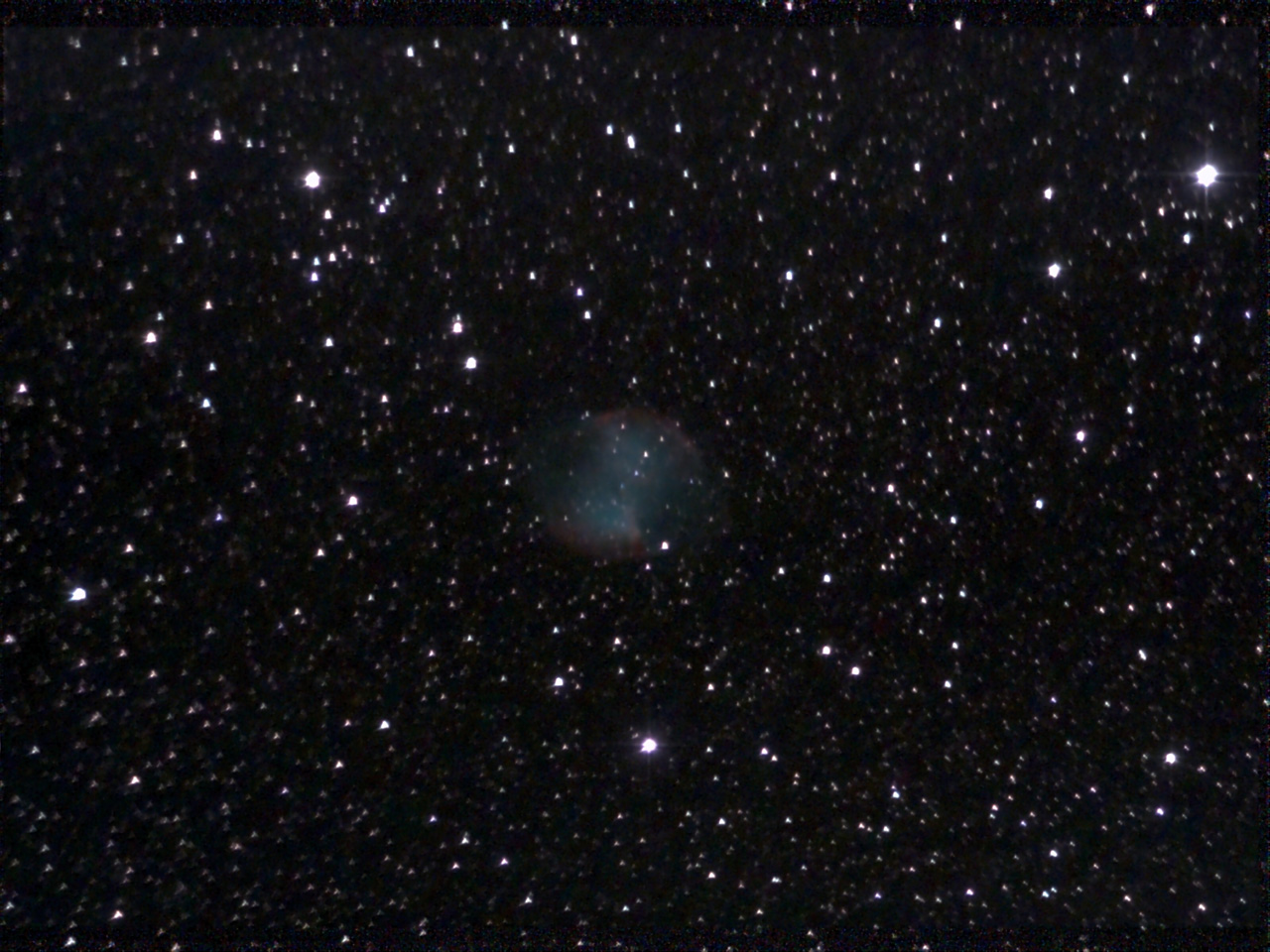 |
|
M 27 - eVscope, Dec 20, 2021, unprocessed (original size) |
M 27 - eVscope 2, Dec 20, 2021, unprocessed (original size) |
While the first eVscope photo (top left) looks good (collimation only checked), on the second and third photo my collimation (despite a good collimation image) seems to have degraded the image quality. The eVscope 2 photos (right column) show elongated stars; apparently my collimation attempts have degraded the image quality again compared with Dec 10, 2021.... Otherwise, the image quality of the eVscope 2 would be comparable to that of Dec 10, 2021, despite a longer transport in the car.
December 21, 2021, Mühlhausen
On the second day in Mühlhausen, I again used M 27 as a test object for my collimation experiments. While I thought that I were able to see a slight improvement with the eVscope 2, unfortunately I seemed to have further deteriorated the collimation of the eVscope...
Since the eVscope 2 again gave slightly better results after collimation (but not better than the eVscope...), I used it to observe a number of other objects. With the original eVscope, I observed only the globular cluster M 71 (as an object with many stars) and M 42 (as an object which could not satisfy with the original eVscope). After a break, Orion came "around the corner", and I took advantage of that right away! And comparing the M 42 images, I thought for the first time that I was ablet to see an advantage for the eVscope 2...
SQM 19,2-19,3; 6:15-8:30 p.m., after supper again from 10:45-11:30 p.m.
| eVscope | eVscope 2 | |
| iPhone (6:15-7:30 p.m., 11:05-11:15 p.m.): Collimation checked, M 27, collimation, M 27, M 71, break, M 42 | iPhone (6:40-8:25 p.m., 10:45-11:30 p.m.): Collimation, M 27, M 71, M 33, M 31, NGC 869 (h Persei), NGC 884 (chi Persei), NGC 7331, NGC 891, break, M 45, M 42, NGC 2024 (Flammennebel), NGC 1977 (Running Man Nebula), M 78 |
Images on my iPhone 7 (eVscope 2) appeared too faint because the screen brightness was set too low; after that, the images from both telescopes looked quite similar...
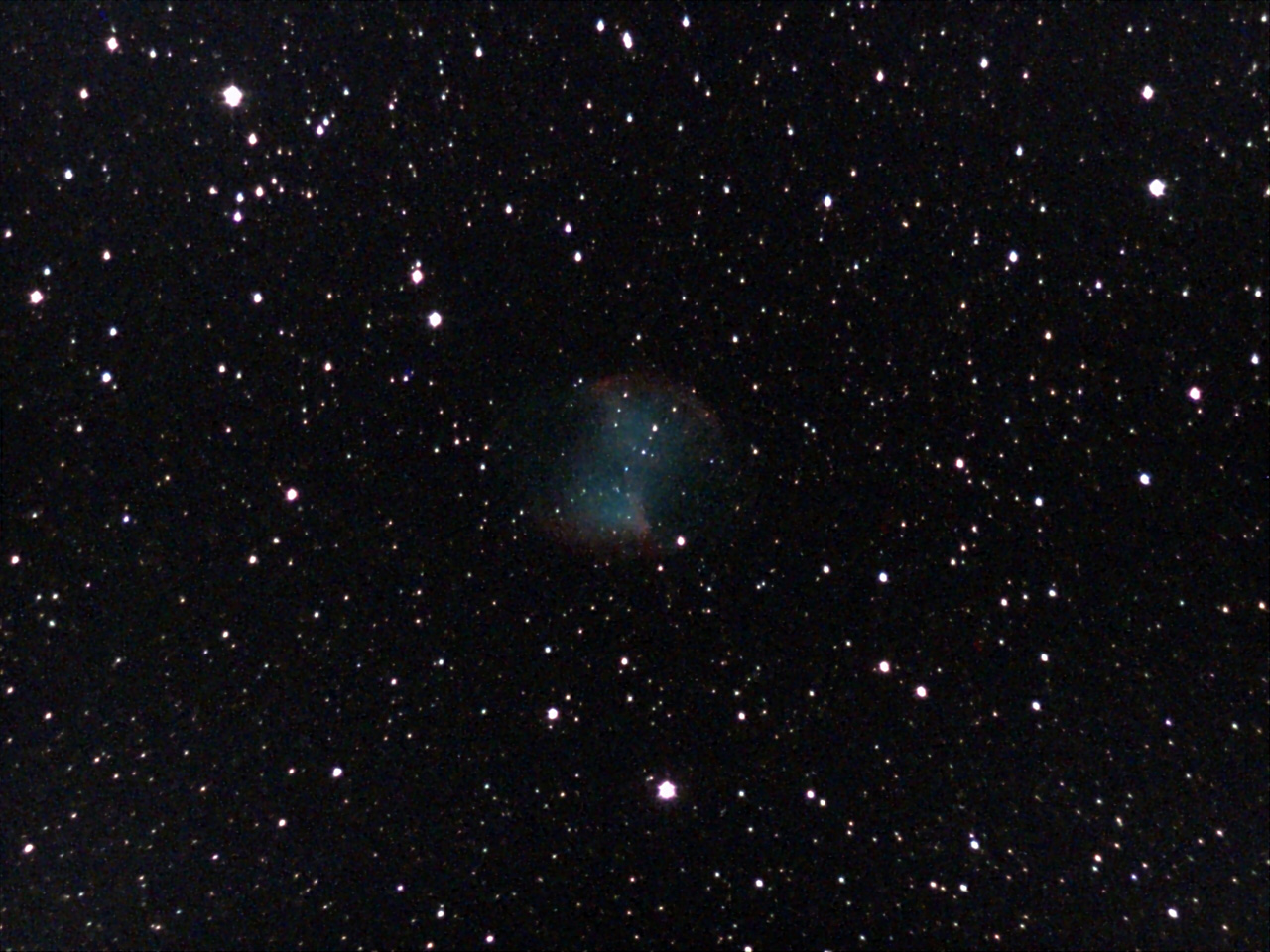 |
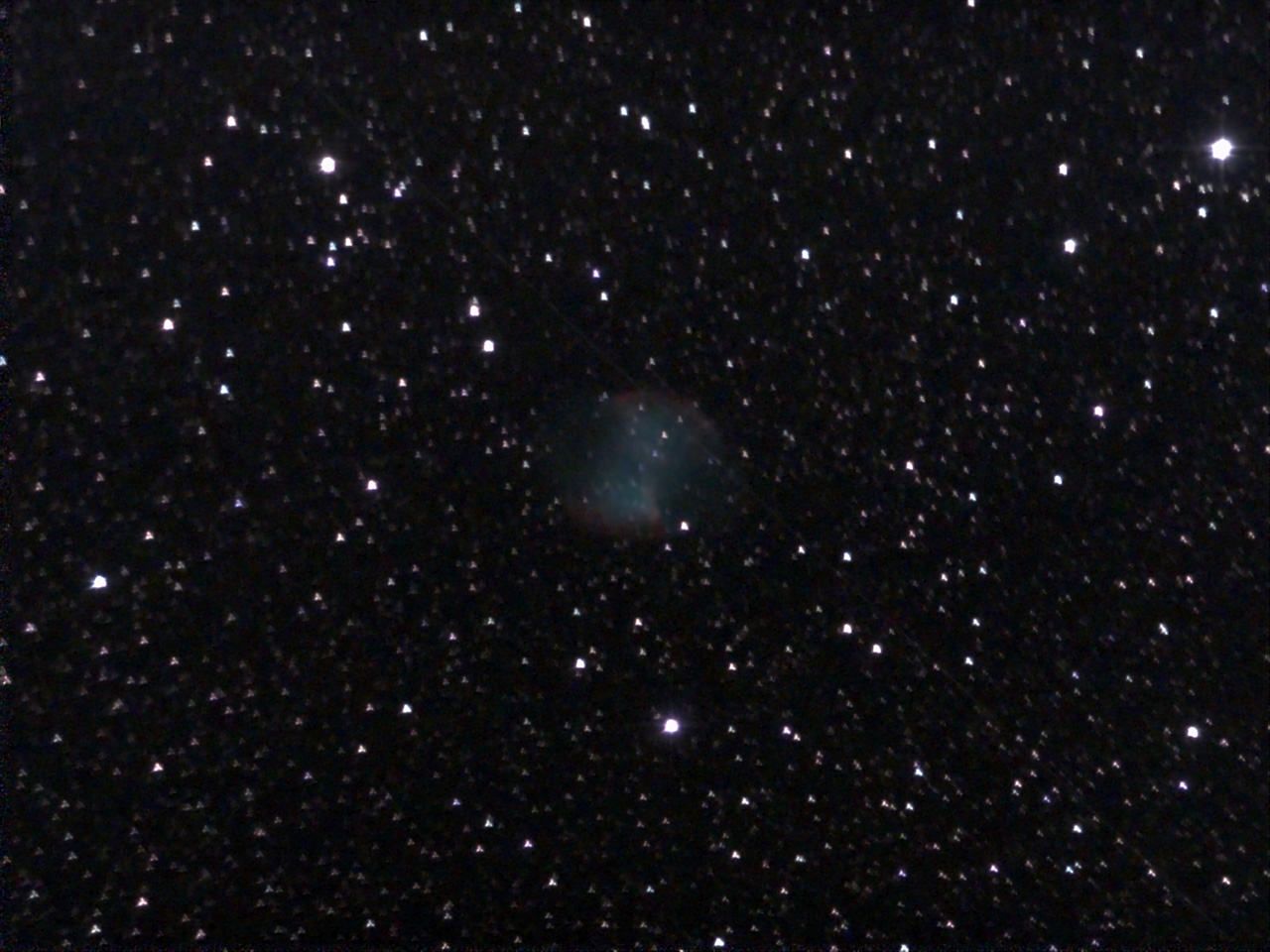 |
|
M 27 - eVscope, Dec 21, 2021, unprocessed (original size), after collimation (short exposure time) |
M 27 - eVscope 2, Dec 20, 2021, unprocessed (original size), after first collimation (made worse!) |
|
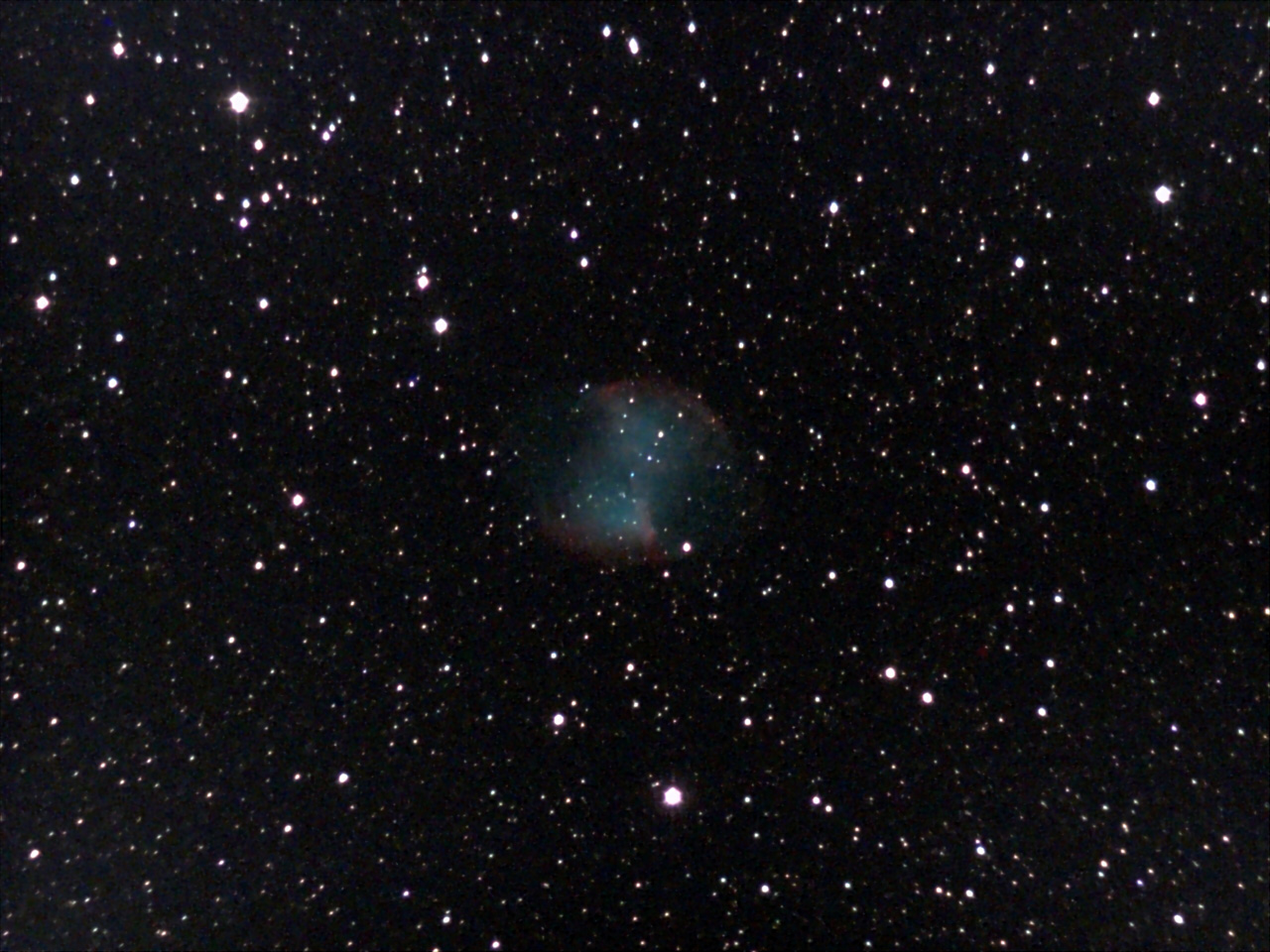 |
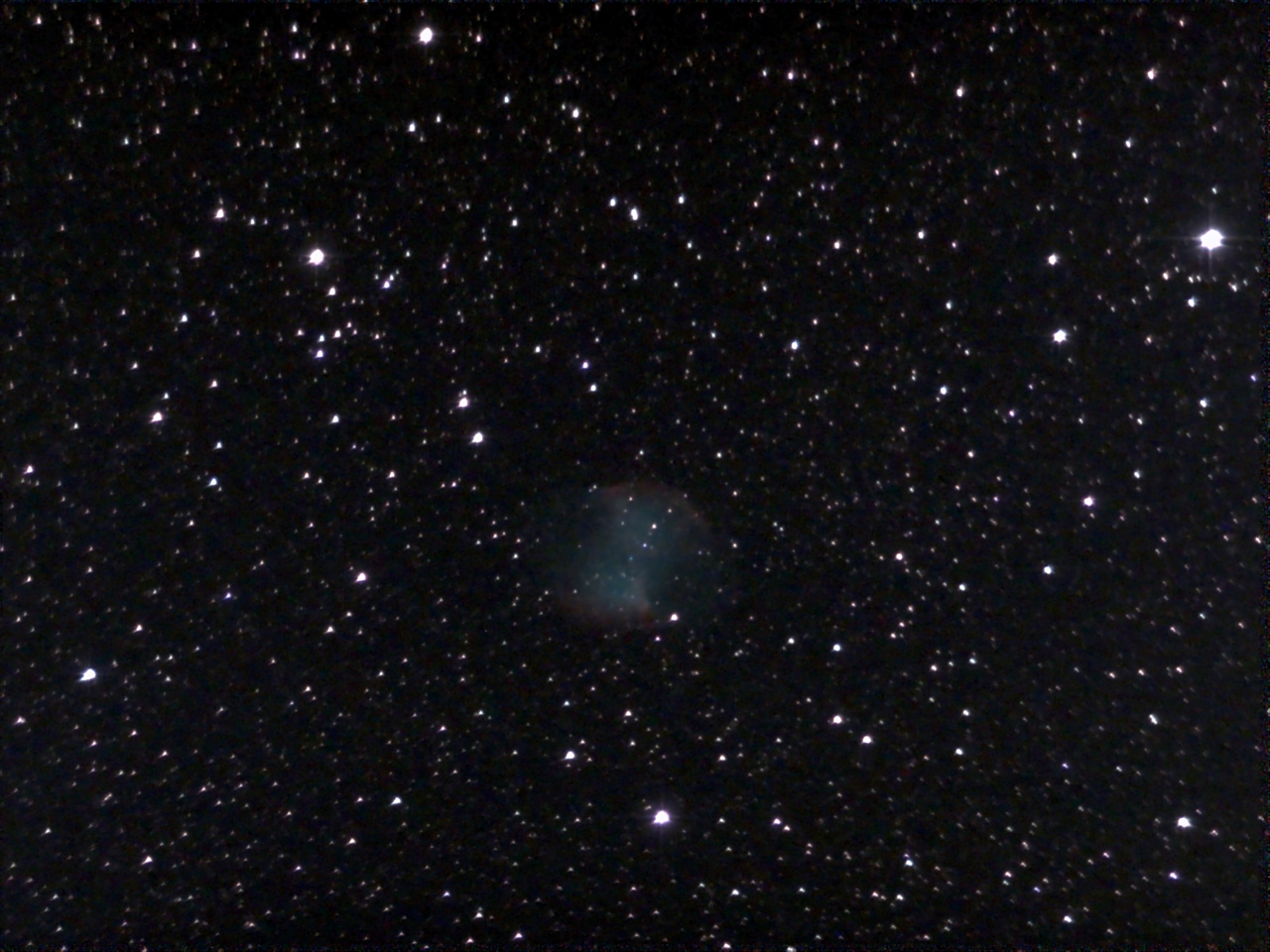 |
|
M 27 - eVscope, Dec 21, 2021, unprocessed (original size), after collimation (longer exposure time) |
M 27 - eVscope 2, Dec 20, 2021, unprocessed (original size), after second collimation (improved) |
|
 |
 |
|
M 27 - eVscope 2, Dec 5, 2021, unprocessed (original size), for comparison (starting state) |
M 27 - eVscope 2, Dec 10, 2021, unprocessed (original size), for comparison (best collimation up to now) |
With the eVscope, I was able to improve the collimation a bit again, but it has not yet reached the good previous state. With the eVscope 2, I achieved the worst state so far with my first collimation attempt. With my second attempt it became better, but still not as good as on Dec 10, 2021. So there is still some work to do!
Collimation Examples
Below, I took screenshots during collimation and of some results afterwards; the first two images show the collimation at the eVscope that I made worse. All the other images show collimation attempts and the results on the eVscope 2:
All in all, I found it difficult to symmetrically adjust the collimation image, which was also not entirely stable. The longer exposures reveal that there do not seem to be tracking issues with my eVscope 2.
Here are comparison photos of M 42 and M 71, which I took on Dec 21, 2021 with both eVscopes:
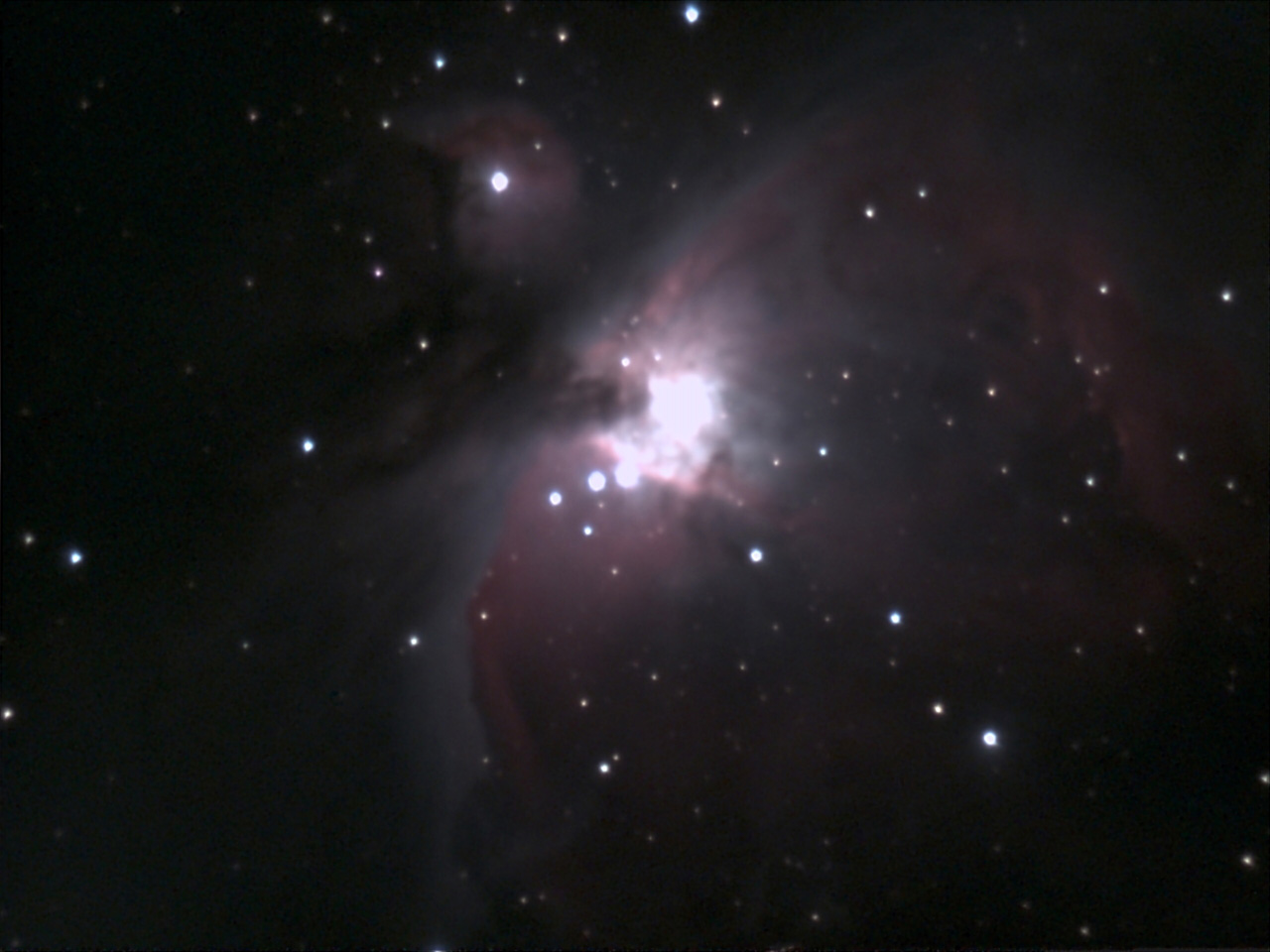 |
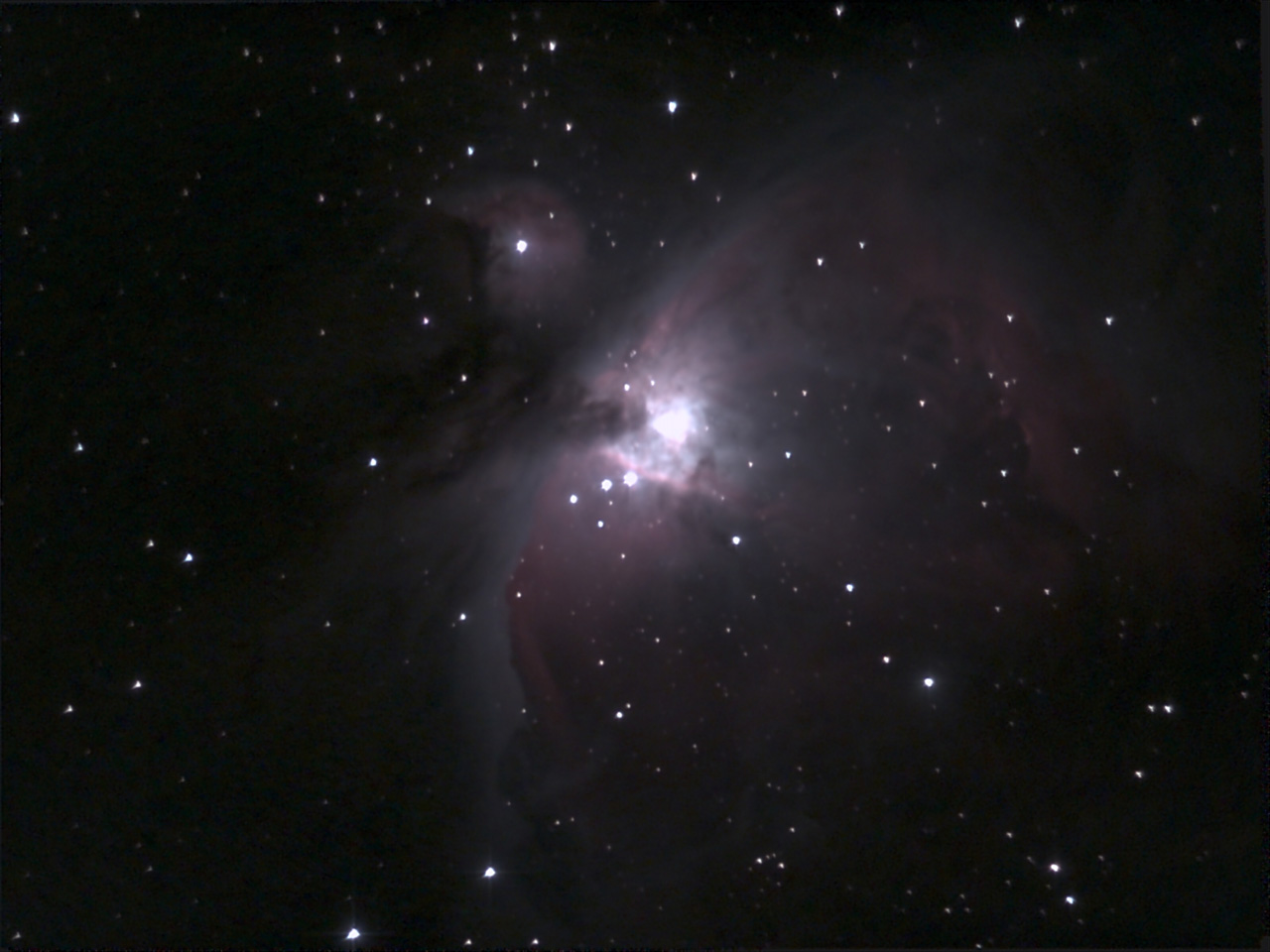 |
|
M 42 - eVscope, Dec 21, 2021, unprocessed (original size) |
M 42 - eVscope 2, Dec 21, 2021, unprocessed (original size) |
|
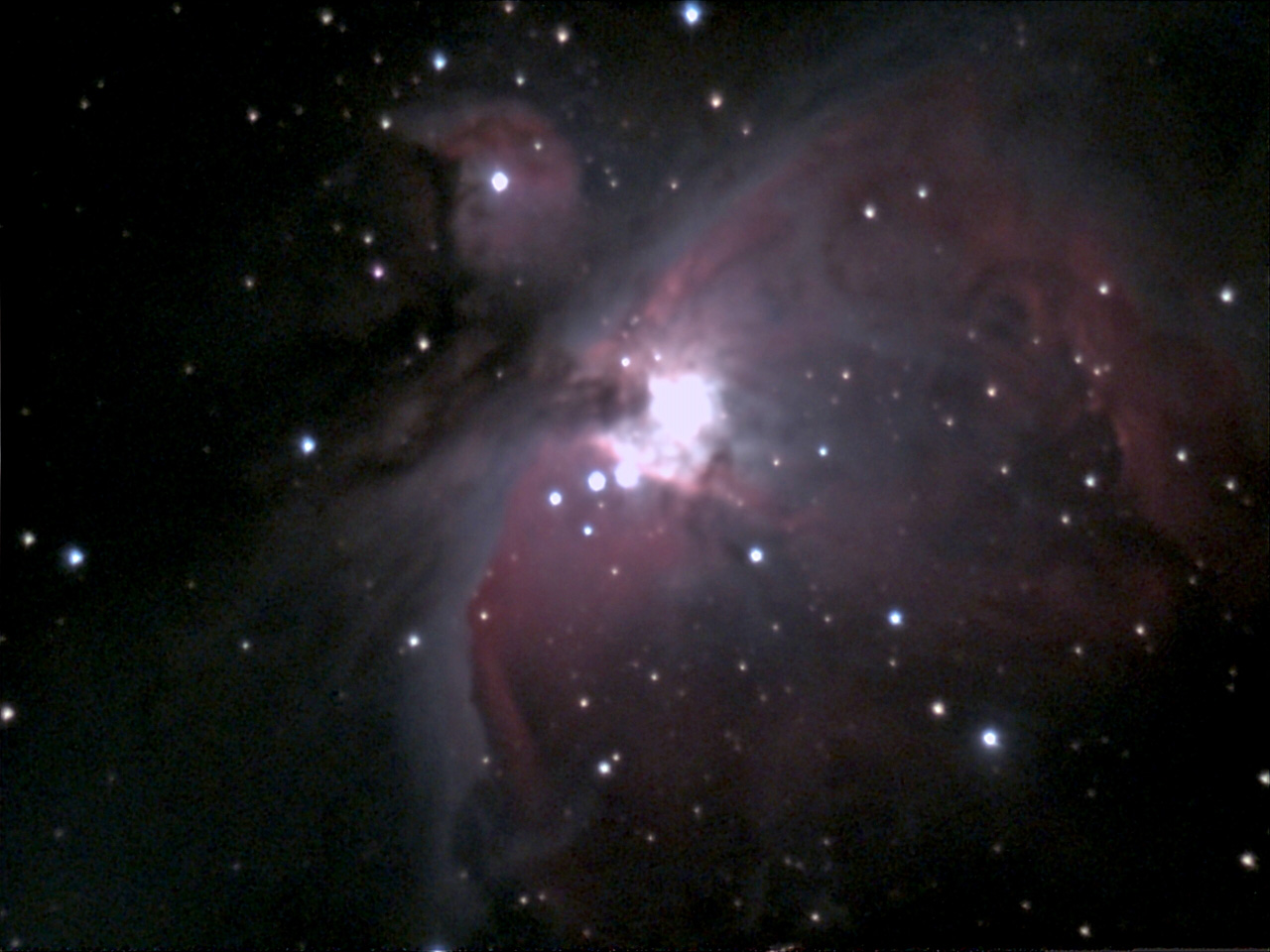 |
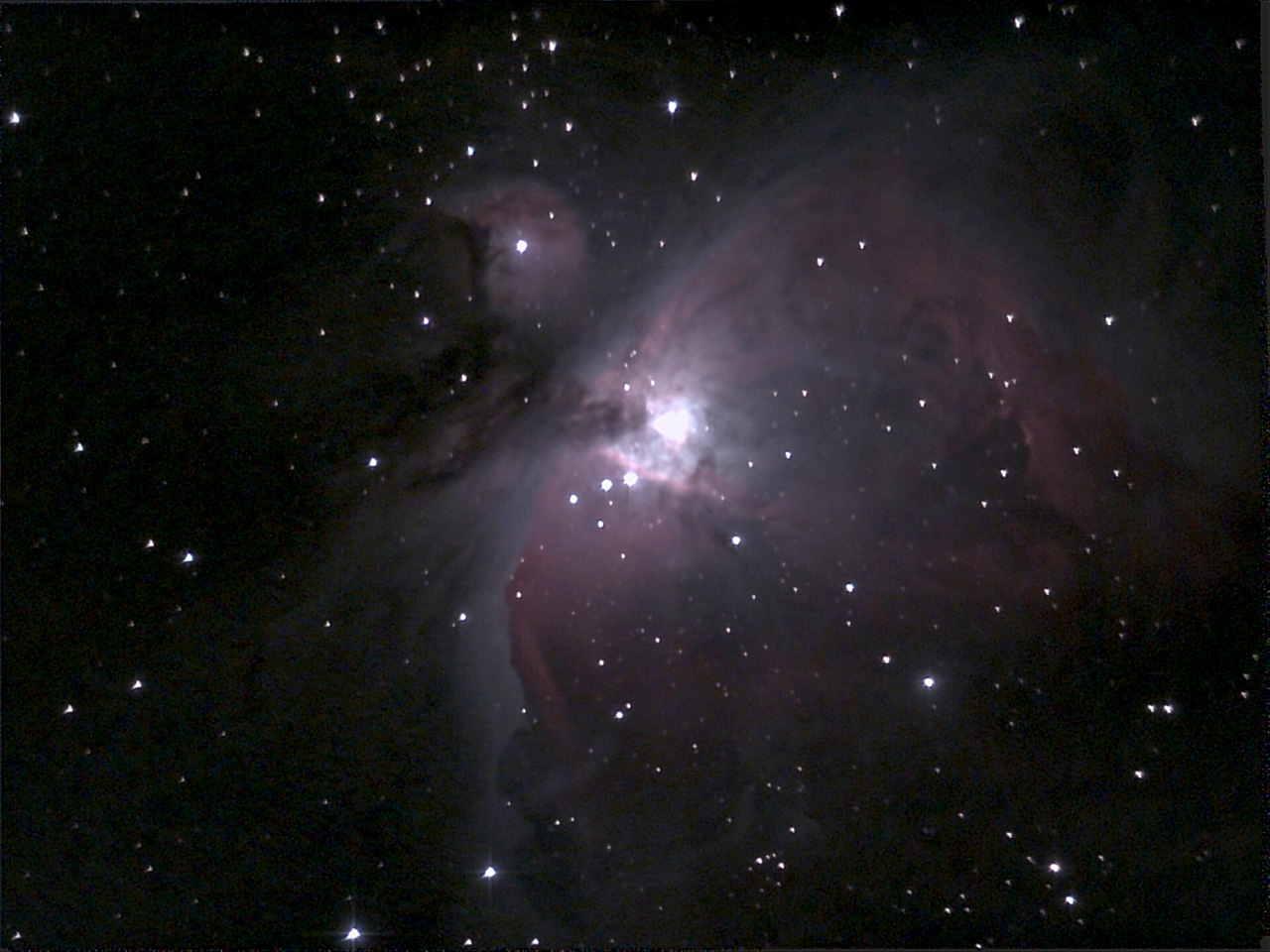 |
|
M 42 - eVscope, Dec 21, 2021, post-processed (original size) |
M 42 - eVscope 2, Dec 21, 2021, post-processed (original size) |
|
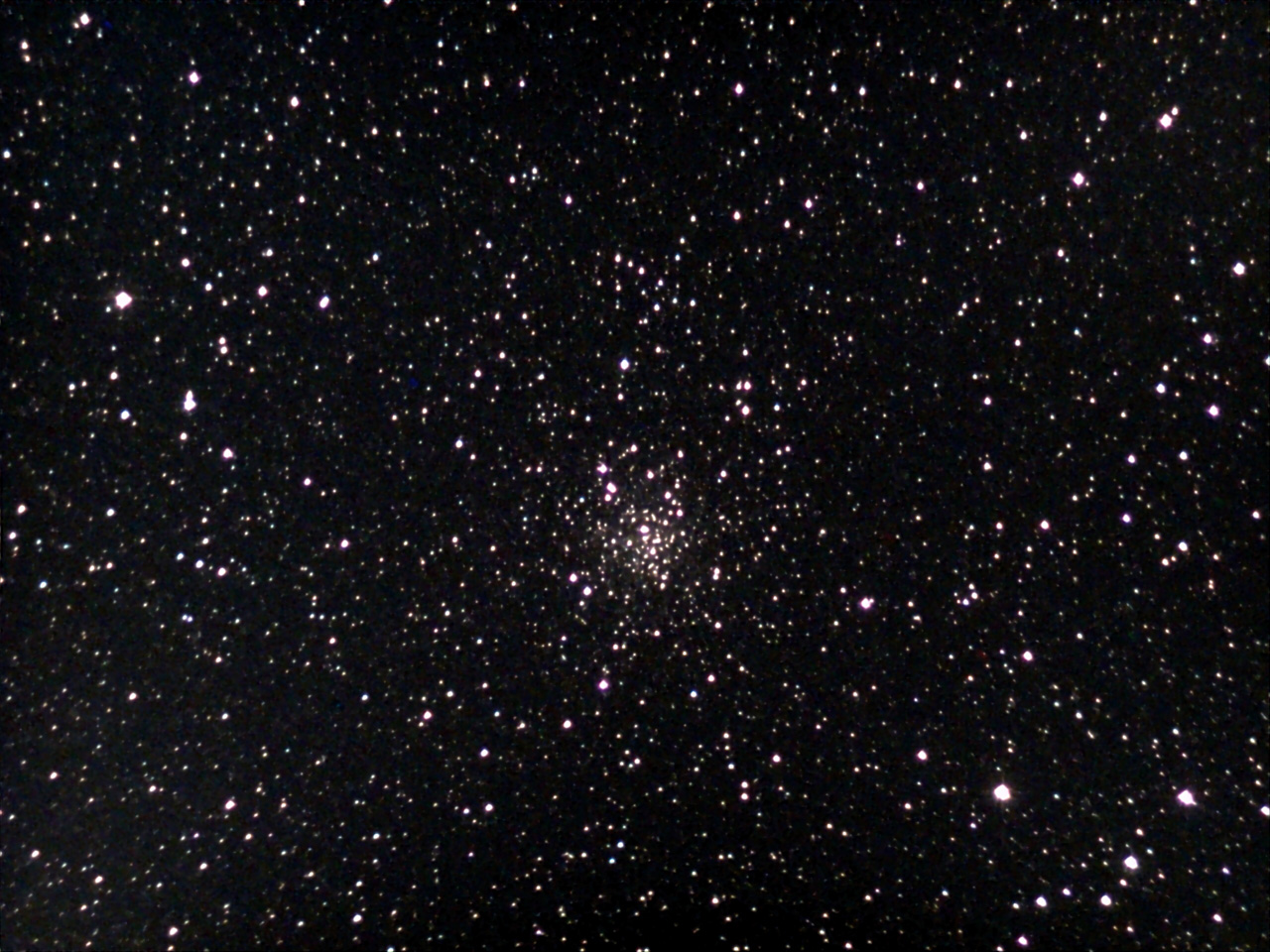 |
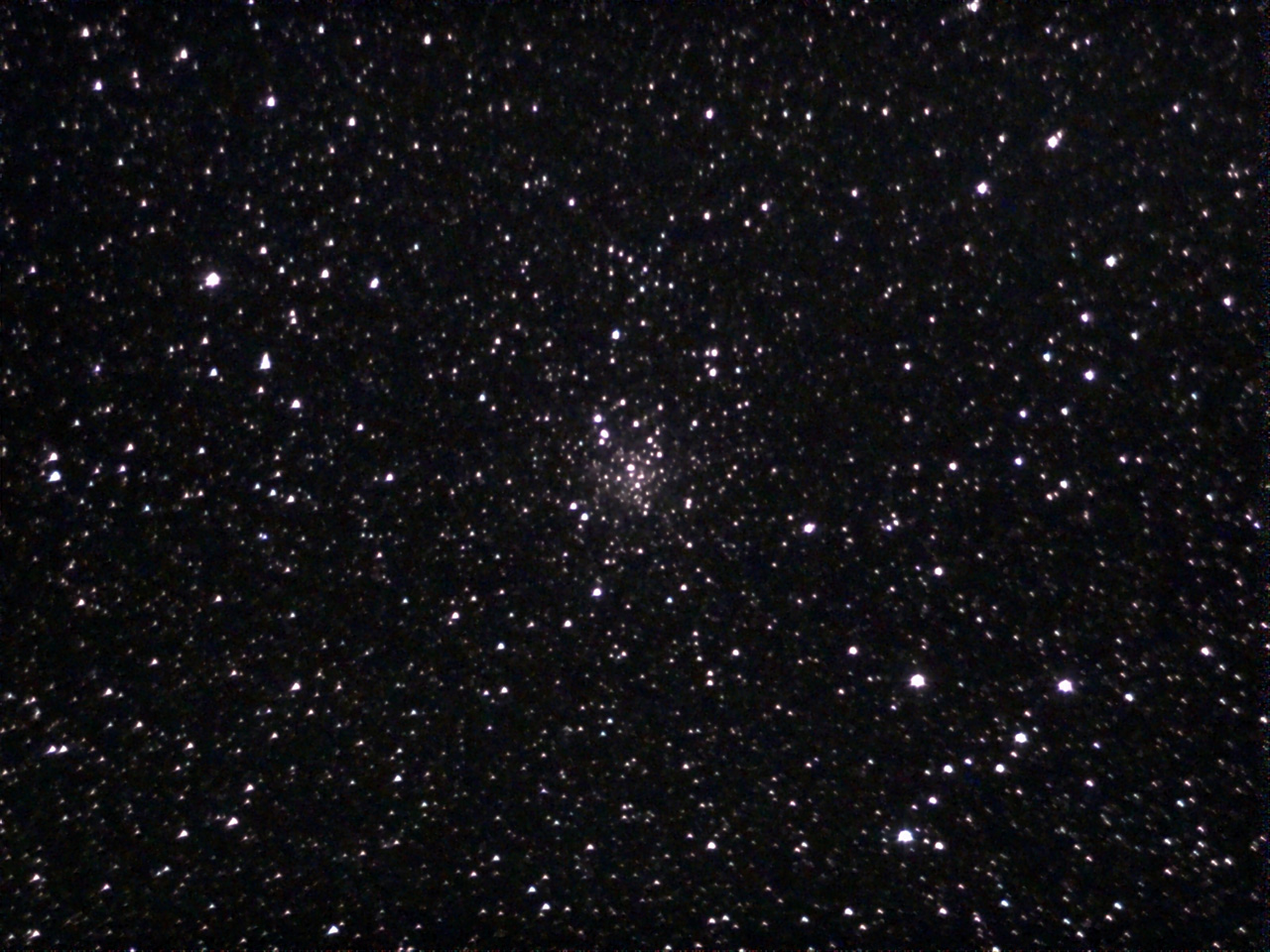 |
|
M 71 - eVscope, Dec 21, 2021, unprocessed (original size) |
M 71 - eVscope 2, Dec 21, 2021, unprocessed (original size) |
At least with M 42, I see for the first time that the eVscope 2 shows a nicer image. But M 42 was always one of the weak points of the original eVscope...
On a separate page, I show photos of other DSO, which I took on this day!
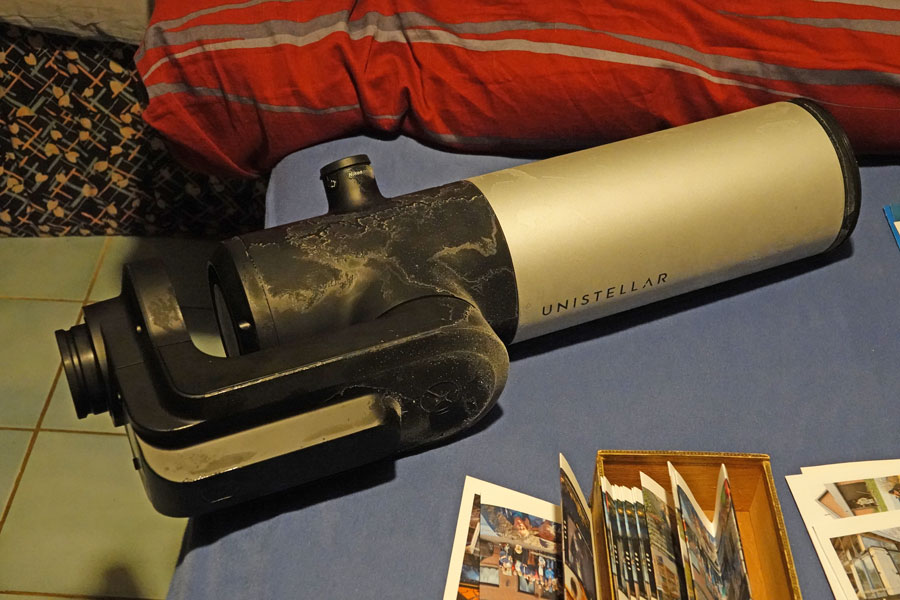
Photo: eVscope 2 after the observation session
Conclusions
On December 20 and 21, 2021 I was able to compare the new eVscope 2 with the original eVscope at home for the first time. For this purpose, I made several collimation attempts, but basically made everything only worse - not only for the eVscope 2, but also for the eVscope. Interesting for me was the comparison of the two telescopes at the Orion Nebula M 42; there, I had for the first time the impression that the eVscope 2 took the nicer photo.
Further Experiences in 2022
January 6, 2022
After I had sent a few first photos taken with my new Unistellar eVscope2 to Anna at Unistellar and showed some disappointment with respect to the achieved results (see page First Photos), Anna promised to forward my e-mail to the technical department at Unistellar. Soon after, the support of Unistellar contacted me and asked for some test photos showing (1) the collimation pattern (the cross that the spider creates when the telescope is misfocused) and (2) the pattern that the Bahtinov mask creates, when a star is focused. Furthermore, the support asked me to take a movie, while I was turning the focus wheel from one end to the other. Since I did not know how to create a movie of this, we agreed that I send photos that I took during the movements of the focus wheel. Since the night sky was overcast for many days, I was not able to tackle these tasks until January 6, 2022.
After the tests were done (and before the clouds came...), I took some photos with the eVscope 2.
For details, see page First Experiences (Collimation Test).
January 24, 2022
To my surprise, the sky was clear on January 24, 2022 (and it was cold), and so I was finally able to compare my new eVscope 2 directly with my original eVscope. In the beginning, the observations were a bit out of sync, but later they were done almost in parallel. I controlled the eVscope with my wife's iPhone 6s and the eVscope 2 with my iPad and later also in parallel with my iPhone 7. This allowed for an easier comparison of the screen images. I also set my iPhone 7 for the eVscope 2, to display an "overlay" to get the labeling.
First, however, I set off to re-collimate the eVscope 2, because the existing collimation was inadequate. I first tried this on Jupiter, but that proved difficult. Then, I tried the star Algenib, and, because it was not bright enough, I used the star Aldebaran for the collimation. After observing the Pleiades M 45, I accessed the Triangulum Galaxy M 33 and discovered "triangular" stars on the display. So I collimated once more, and was able to see at M 33 that the collimation was at least a little bit better afterwards. With this collimation state, I probably observed all further DSO with the eVscope 2. I also re-collimated the original eVscope, but I forgot the details... In any case, I observed the same objects with it as with the eVscope 2, so the external conditions were comparable this time (SQM between 19.7 and a little more than 20).
For details, see page First Experiences (Photo Comparison).
February 5, 2022
On February 5, 2022, I made further tests with the eVscope 2, looking at how the star images change when the focus is slightly changed (off). I took screenshots of these photos, but I do not want to present them here, because it has since become apparent that the mirror of my eVscope 2 was strained (in the meantime, my eVscope 2 was repaired, but I do not have it back at the moment, because I am on vacation). However, I present three more photos that I took directly after these tests.
Problem: Tracking error with M 42, EV rarely got beyond 30 seconds, EV mode duration time stopped (same problem as Mr. Deeg had with M 42).
DSO from February 5, 2022
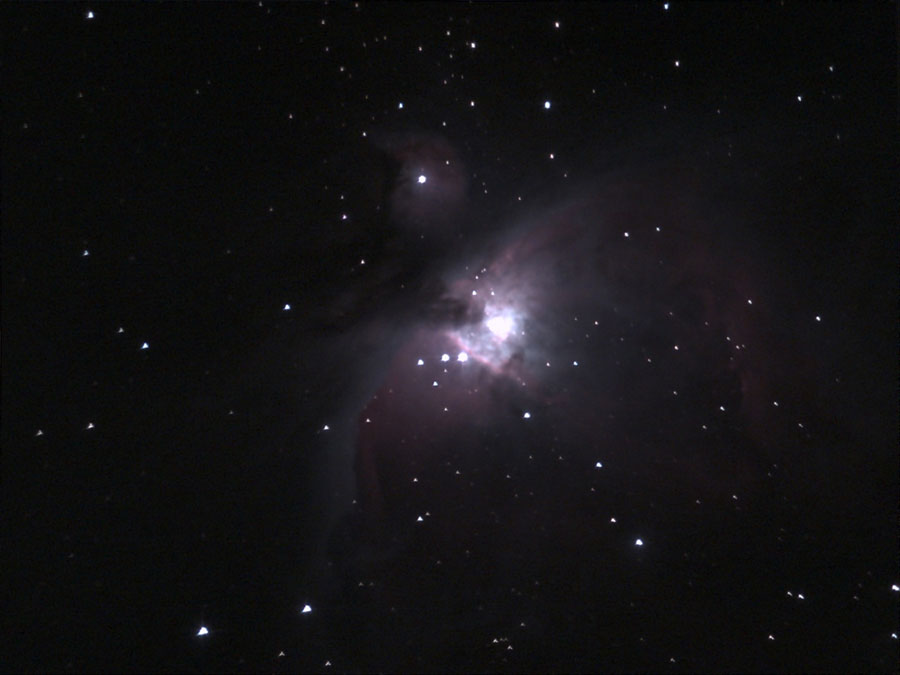 |
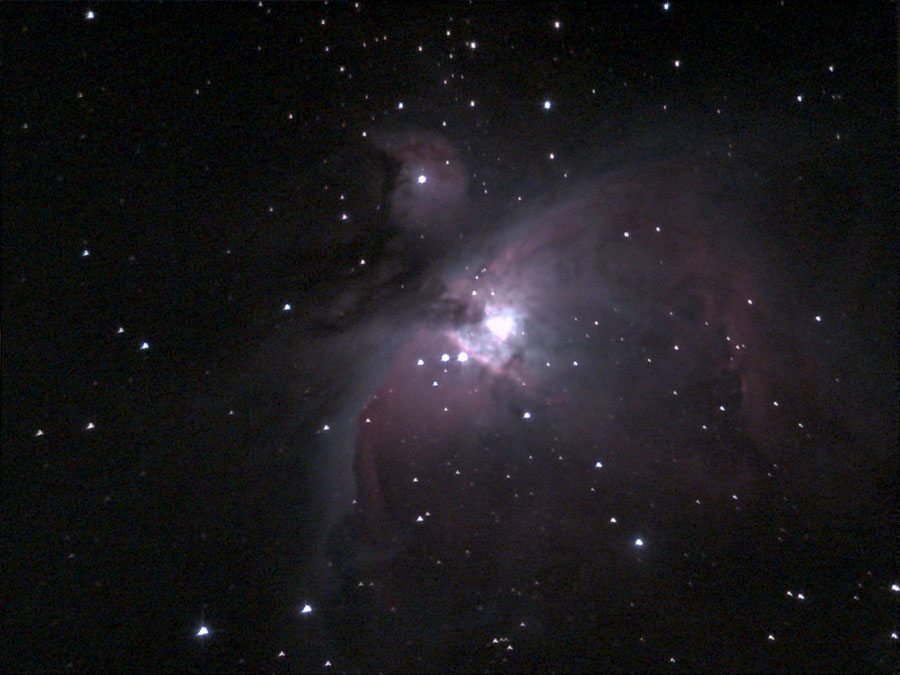 |
|
M 42 (Orion Nebula) |
M 42, processed |
|
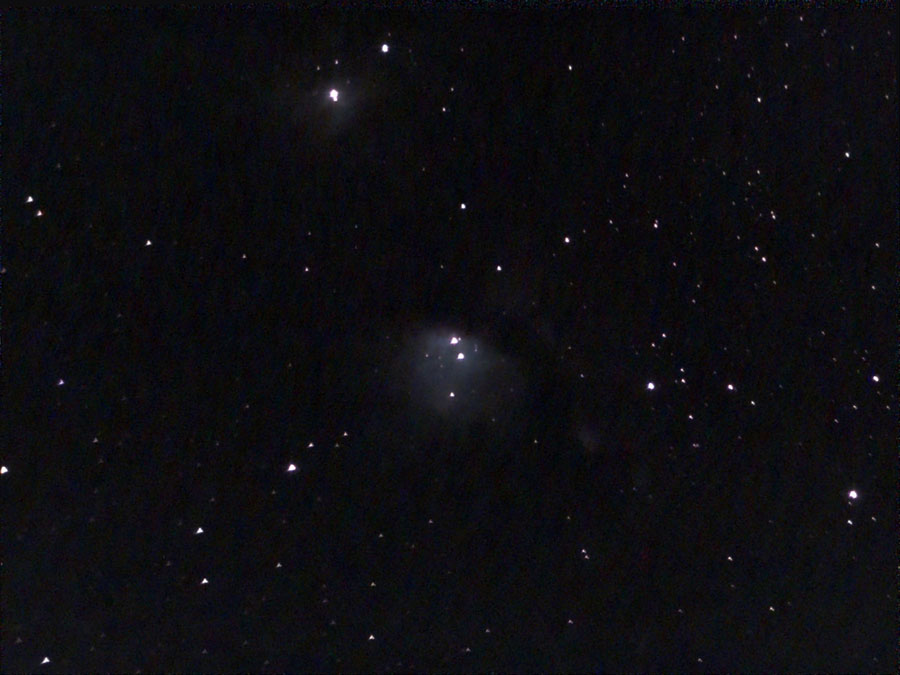 |
||
M 78 |
M 78, processed |
|
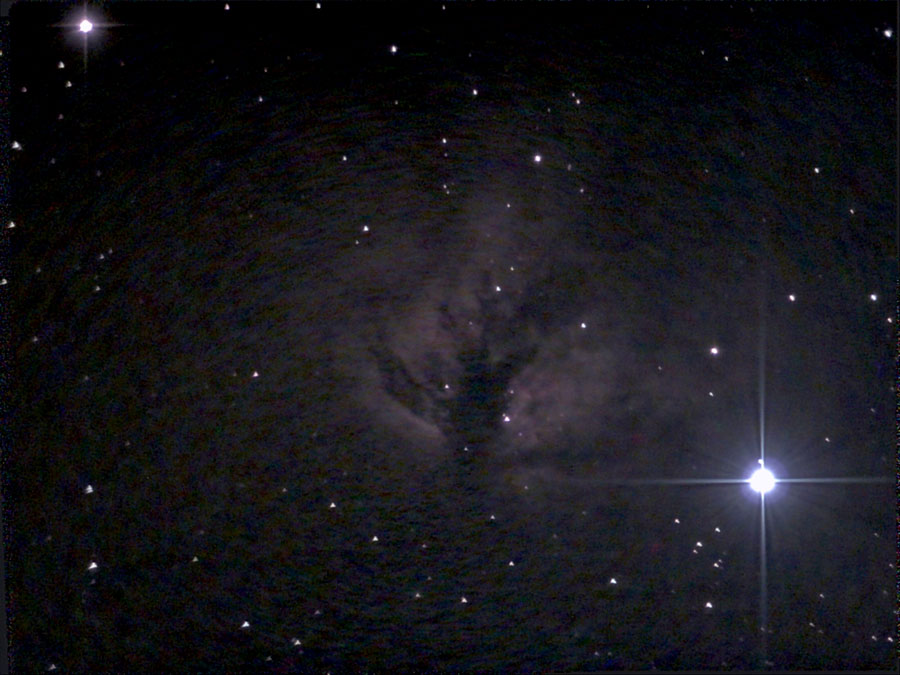 |
||
NGC 2024 (Flame Nebula), appearing clouds |
NGC 2024 (Flame Nebula), processed, appearing clouds |
WLAN - Blues or Not?
During my first two sessions in Mühlhausen, the eVscope 2 and the eVscope stood on the terrace, and I went to the kitchen a few times to show my wife pictures of the eVscope 2. I had the impression that the WiFi connection dropped at least less often, than it was the case with the eVscope. But I did not compare the two directly. Since Unistellar does not comment on this topic, I assume that they dit make any no changes to the WiFi... (In the meantime, I learned that the Raspberry Pi, which is also built into the eVscope, has problems regarding the WiFi range. For a better WiFi range, an external antenna would be needed, as the new version of the ASIAir astronomy computer, for example, has built-in).
First Conclusions
Since I was initially in our vacation apartment, where I had the eVscope 2 sent to me, I was initially only able to test this one. At the beginning, the photos were very disappointing, also because the sharpness was insufficient despite the use of the Bahtinov mask. Later collimation attempts, then also in Mühlhausen with both eVscopes brought an "up and down", but unfortunately no good collimation. Nevertheless, besides the test object M 27, I observed some more DSO with the eVscope 2 and partly also with the eVscope. Especially the comparison at the Orion Nebula M 42 was interesting for me.
At that time, I did not know, whether I would do further comparisons between the two telescopes. For a comparison with existing eVscope photos, I would have to make sure that the eVscope DSO were already captured with the new image processing (from App.Version 1.3) to allow a fair comparison. In fact, I observed further objects with both telescopes on January 24, 2021, partly even in parallel. More about this on page (in preparation)...
With the eVscope 2, more collimation attempts are definitely needed to achieve a better image quality. However, it seems to me that the eVscope 2 will always show worse star forms than the original eVscope (which is also not perfect in this respect...). In any case, I believe to have come closer to the original eVscope with the eVscope 2, but it is still a long way to the samples that Unistellar has published for the eVscope 2.
I attached some of my eVscope 2 photos to my Christmas greetings for Unistellar, and Anna from Unistellar forwarded them to her technical colleagues - and a colleague of her asked me for some special images (collimation cross etc.). This is described on page First Experiences (Collimation Test).
Update: Since I was not satisfied with the results of my new eVscope 2, Unistellar offered to check and possibly repair my eVscope 2. So, I sent it to Unistellar on February 14, 2022 and received information on February 18 that my eVscope 2 had been repaired and will be returned to me. When asked, I was told that there was a problem with the primary mirror, which was slightly under tension and therefore produced blurry images. As proof of the repair, I received a photo of Alnilam, which was taken with my eVscope 2 after the repair. It looks much better than my similar photo of Alnitak (near the Flame Nebula), but at closer look still exhibits triangular stars):
In March 2022, I was able to take first photos with my repaired eVscope 2. Read pages First Experiences (After Repair - Part 1) and First Experiences (After Repair - Part 2) for more information! According to this, the repair resulted in an improvement, but did not completely eliminate the mirror tension. Unistellar therefore offered me to return my eVscope 2 (end of March 2022) and exchange it for a new one. This arrived on April 8, 2022. So I close the pages for my first eVscope 2 sample!
So please note that my eVscope 2 photos on this page do not reflect the true performance of the eVscope 2!
Links
- Unistellar Website: unistellaroptics.com
- eVscope Kickstarter campaign: www.kickstarter.com/projects/unistellar/evscope-100-times-more-powerful-than-a-classical-t/
- See also my page offering Astronomy Links.
| 20.09.2022 |




